Psa-type Liquid Crystal Composition And Display Device Having Same
Ma; Wenyang ; et al.
U.S. patent application number 16/832251 was filed with the patent office on 2020-10-22 for psa-type liquid crystal composition and display device having same. This patent application is currently assigned to Jiangsu Hecheng Display Technology Co., Ltd.. The applicant listed for this patent is Jiangsu Hecheng Display Technology Co., Ltd.. Invention is credited to Wenming Han, Wenyang Ma, Liwei Wang, Haibin Xu, Weigang Yan.
| Application Number | 20200332195 16/832251 |
| Document ID | / |
| Family ID | 1000004783748 |
| Filed Date | 2020-10-22 |







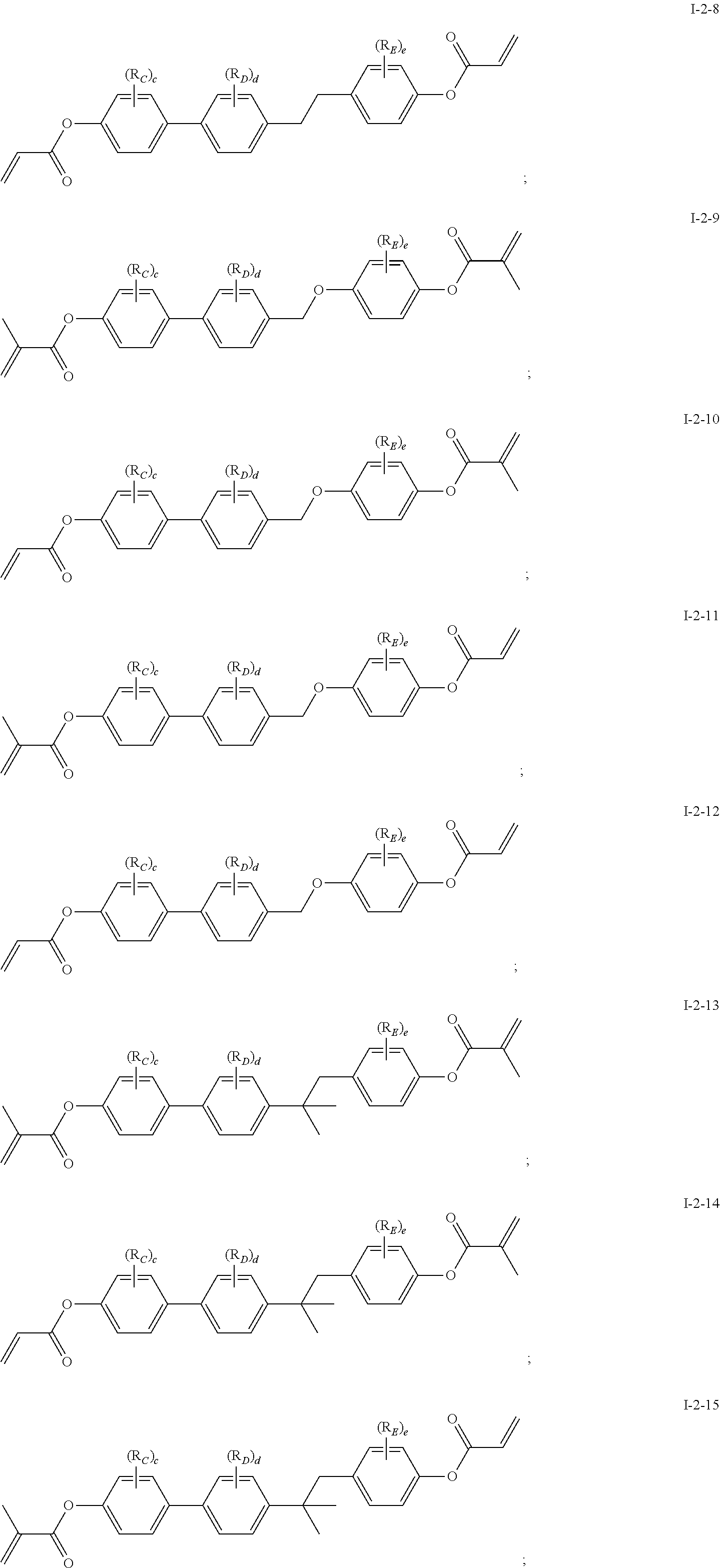

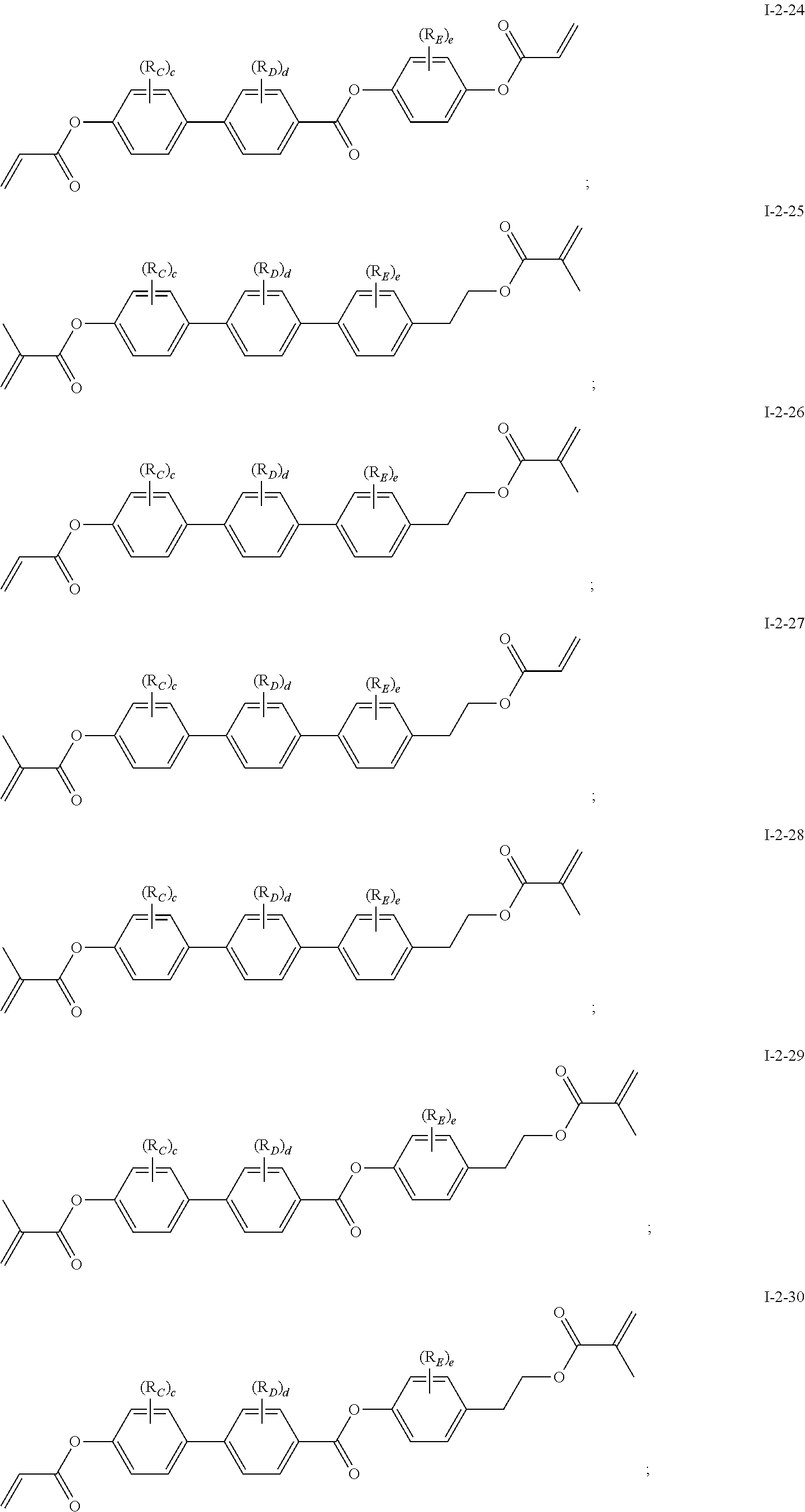


View All Diagrams
| United States Patent Application | 20200332195 |
| Kind Code | A1 |
| Ma; Wenyang ; et al. | October 22, 2020 |
PSA-TYPE LIQUID CRYSTAL COMPOSITION AND DISPLAY DEVICE HAVING SAME
Abstract
A PSA-type liquid crystal composition includes a host liquid crystal A and a polymerizable component B, where the host liquid crystal A includes one or more liquid crystal compounds, and the polymerizable component B includes at least one compound selected from compounds of general formula I-1, general formula I-2 and general formula I-3. A liquid crystal display device includes the PSA-type liquid crystal composition above. The PSA-type liquid crystal composition has better intersolubility, cannot be crystallized at a low-temperature environment, can form a relatively stable pretilt angle after the polymerization of the polymerizable component, avoids the image sticking, and inhibits the occurrence of a display defect, such as Zara Particle, during the polymerization. ##STR00001##
| Inventors: | Ma; Wenyang; (Yangzhong City, CN) ; Wang; Liwei; (Yangzhong City, CN) ; Yan; Weigang; (Yangzhong City, CN) ; Han; Wenming; (Yangzhong City, CN) ; Xu; Haibin; (Yangzhong City, CN) | ||||||||||
| Applicant: |
|
||||||||||
|---|---|---|---|---|---|---|---|---|---|---|---|
| Assignee: | Jiangsu Hecheng Display Technology
Co., Ltd. Yangzhong City CN |
||||||||||
| Family ID: | 1000004783748 | ||||||||||
| Appl. No.: | 16/832251 | ||||||||||
| Filed: | March 27, 2020 |
| Current U.S. Class: | 1/1 |
| Current CPC Class: | C09K 2019/3016 20130101; C09K 2019/3004 20130101; C09K 19/3003 20130101; C09K 2019/301 20130101; C09K 2019/548 20130101; C09K 19/544 20130101; C09K 2019/3009 20130101; C09K 19/3066 20130101 |
| International Class: | C09K 19/54 20060101 C09K019/54; C09K 19/30 20060101 C09K019/30 |
Foreign Application Data
| Date | Code | Application Number |
|---|---|---|
| Apr 16, 2019 | CN | 201910304707.4 |
Claims
1. A PSA-type liquid crystal composition comprising: a host liquid crystal A and a polymerizable component B, wherein the host liquid crystal A comprises one or more liquid crystal compounds, and the polymerizable component B comprises at least one compound selected from a group consisting of the compounds of general formula I-1, general formula I-2 and general formula I-3: ##STR00075## in which, ring A, ring B, ring C, ring D, ring E, ring F, ring G, ring H and ring I each independently represents phenylene or naphthylene; X.sub.1-1, X.sub.1-2, X.sub.1-3, X.sub.2-1, X.sub.2-2, X.sub.2-3, X.sub.2-4, X.sub.3-1, X.sub.3-2, X.sub.3-3, X.sub.3-4 and X.sub.3-5 each independently represents a single bond, or a C.sub.1-12 linear or branched alkylene, wherein one or more --CH.sub.2-- in the C.sub.1-12 linear or branched alkylene can be replaced by --O--, --S--, --NH--, --CO--, --CH.dbd.CH-- or --C.ident.C-- in a manner that heteroatoms are not directly connected to each other, --H in one or more --CH.sub.2-- in the C.sub.1-12 linear or branched alkylene can be substituted by halogen, and wherein at least one of X.sub.1-1, X.sub.1-2 and X.sub.1-3 represents a single bond, at least one of X.sub.2-1, X.sub.2-2, X.sub.2-3 and X.sub.2-4 represents a single bond, and at least one of X.sub.3-1, X.sub.3-2, X.sub.3-3, X.sub.3-4 and X.sub.3-5 represents a single bond; R.sub.A, R.sub.B, R.sub.C, R.sub.D, R.sub.E, R.sub.F, R.sub.G, R.sub.H and R.sub.I each independently represents halogen, or a C.sub.1-5 halogenated or unhalogenated linear or branched alkyl or alkoxy; P.sub.1-1, P.sub.1-2, P.sub.2-1, P.sub.2-2, P.sub.3-1 and P.sub.3-2 each independently represents a polymerizable group; a, b, c, d, e, f, g, h and i each independently represents 0, 1, 2 or 3, and when a is 2 or 3, R.sub.A can be same or different; when b is 2 or 3, R.sub.B can be same or different; when c is 2 or 3, R.sub.C can be same or different; when d is 2 or 3, R.sub.D can be same or different; when e is 2 or 3, R.sub.E can be same or different; when f is 2 or 3, R.sub.F can be same or different; when g is 2 or 3, R.sub.G can be same or different; when h is 2 or 3, R.sub.H can be same or different; when i is 2 or 3, R.sub.I can be same or different; a+b+n.sub.1.gtoreq.1, and n.sub.1.gtoreq.1, wherein n.sub.1 represents the number of groups that are not single bond in X.sub.1-1, X.sub.1-2 and X.sub.1-3; c+d+e+n.sub.2.gtoreq.2, and n.sub.2.gtoreq.1, wherein n.sub.2 represents the number of groups that are not single bond in X.sub.2-1, X.sub.2-2, X.sub.2-3 and X.sub.2-4; and f+g+h+i+n.sub.3.gtoreq.3, and n.sub.3.gtoreq.1, wherein n.sub.3 represents the number of groups that are not single bond in X.sub.3-1, X.sub.3-2, X.sub.3-3, X.sub.3-4 and X.sub.3-5.
2. The PSA-type liquid crystal composition according to claim 1, wherein a+b+n.sub.1.gtoreq.2; c+d+e+n.sub.2.gtoreq.3; and f+g+h+i+n.sub.3.gtoreq.4.
3. The PSA-type liquid crystal composition according to claim 1, wherein X.sub.1-2, X.sub.2-2, X.sub.2-3, X.sub.3-2, X.sub.3-3 and X.sub.3-4 each independently represents a single bond, --CH.sub.2O--, --OCH.sub.2--, --CH.sub.2CH.sub.2--, --(CH.sub.2).sub.3--, --(CH.sub.2).sub.4--, --(CH.sub.2).sub.3O--, --O(CH.sub.2).sub.3--, --O--, --CF.sub.2--, --CF.sub.2O--, --OCF.sub.2--, --CH(CH.sub.3)CH.sub.2--, --C(CH.sub.3).sub.2CH.sub.2--, --CH.sub.2C(CH.sub.3).sub.2--, --C(CH.sub.3).sub.2CH(CH.sub.3)--, --C(CH.sub.3).sub.2C(CH.sub.3).sub.2--, --C(CH.sub.3).sub.2O--, --OC(CH.sub.3).sub.2--, --CH(CH.sub.2CH.sub.3)CH.sub.2--, --S--, --NH--, --NH--CO--O--, --O--CO--NH--, --SCH.sub.2--, --CH.sub.2S--, --CH.dbd.CH--, --C.ident.C--, --CH.dbd.CH--CO--O-- or --O--CO--CH.dbd.CH.
4. The PSA-type liquid crystal composition according to claim 1, wherein if X.sub.1-2 represents --CO-- or --O--CO--, then a+b.noteq.0; if both X.sub.2-2 and X.sub.2-3 represent --CO--O-- or --O--CO--, then c+d+e.noteq.0; if all of X.sub.3-2, X.sub.3-3 and X.sub.3-4 represent --CO--O-- or --O--CO--, then f+g+h+i.noteq.0.
5. The PSA-type liquid crystal composition according to claim 1, wherein both X.sub.1-1 and X.sub.1-3 represent single bond, and X.sub.1-2 represents --CH.sub.2O--, --OCH.sub.2--, --CO--O--, --O--CO--, --CH.sub.2CH.sub.2--, --(CH.sub.2).sub.3--, --(CH.sub.2).sub.4--, --(CH.sub.2).sub.3O--, --O(CH.sub.2).sub.3--, --O--, --CF.sub.2--, --CF.sub.2O--, --OCF.sub.2--, --CH(CH.sub.3)CH.sub.2--, --C(CH.sub.3).sub.2CH.sub.2--, --CH.sub.2C(CH.sub.3).sub.2--, --C(CH.sub.3).sub.2CH(CH.sub.3)--, --C(CH.sub.3).sub.2C(CH.sub.3).sub.2--, --C(CH.sub.3).sub.2O--, --OC(CH.sub.3).sub.2--, --CH(CH.sub.2CH.sub.3)CH.sub.2--, --S--, --NH--, --NH--CO--O--, --O--CO--NH--, --SCH.sub.2--, --CH.sub.2S--, --CH.dbd.CH--, --C.ident.C--, --CH.dbd.CH--CO--O-- or --O--CO--CH.dbd.CH.
6. The PSA-type liquid crystal composition according to claim 1, wherein the polymerizable component B only comprises one compound of general formula I-1, wherein both X.sub.1-1 and X.sub.1-3 represent single bond, X.sub.1-2 represents --CH.sub.2O--, --OCH.sub.2--, --CO--O--, --O--CO--, --CH.sub.2CH.sub.2--, --(CH.sub.2).sub.3--, --(CH.sub.2).sub.4--, --(CH.sub.2).sub.3O--, --O(CH.sub.2).sub.3--, --O--, --CF.sub.2--, --CF.sub.2O--, --OCF.sub.2--, --CH(CH.sub.3)CH.sub.2--, --CH.sub.2C(CH.sub.3).sub.2--, --C(CH.sub.3).sub.2CH.sub.2--, --C(CH.sub.3).sub.2CH(CH.sub.3)--, --C(CH.sub.3).sub.2C(CH.sub.3).sub.2--, --C(CH.sub.3).sub.2O--, --OC(CH.sub.3).sub.2--, --CH(CH.sub.2CH.sub.3)CH.sub.2--, --S--, --NH--, --NH--CO--O--, --O--CO--NH--, --SCH.sub.2--, --CH.sub.2S--, --CH.dbd.CH--, --C.ident.C--, --CH.dbd.CH--CO--O-- or --O--CO--CH.dbd.CH--, and a+b 0.
7. The PSA-type liquid crystal composition according to claim 1, wherein if the polymerizable component B comprises one compound of general formula I-1 in which a+b+n=1, it at least further comprises another compound selected from a group consisting of the compounds of general formula I-1, general formula I-2 and general formula I-3.
8. The PSA-type liquid crystal composition according to claim 1, wherein at least one of X.sub.2-1 and X.sub.2-4 represents a single bond; and when both X.sub.2-1 and X.sub.2-4 represent single bond, at least one of X.sub.2-2 and X.sub.2-3 is not a single bond, and c+d+e.gtoreq.1.
9. The PSA-type liquid crystal composition according to claim 1, wherein if the polymerizable component B comprises two or three polymerizable compounds, and at least one of said two or three polymerizable compounds is selected from the compounds of general formula I-2, at least one of X.sub.2-1 and X.sub.2-4 represents a single bond, and when both X.sub.2-1 and X.sub.2-4 represent single bond, at least one of X.sub.2-2 and X.sub.2-3 is not a single bond, and c+d+e.gtoreq.1.
10. The PSA-type liquid crystal composition according to claim 1, wherein at least one of X.sub.3-1 and X.sub.3-5 represents a single bond; and when both X.sub.3-1 and X.sub.3-5 are single bond, at least one of X.sub.3-2, X.sub.3-3 and X.sub.3-4 is not a single bond, and f+g+h+i.gtoreq.2; when only one of X.sub.3-1 and X.sub.3-5 represents a single bond, at most one of X.sub.3-2, X.sub.3-3 and X.sub.3-4 is not a single bond, and f+g+h+i.gtoreq.2.
11. The PSA-type liquid crystal composition according to claim 1, wherein if the polymerizable component B comprises two or three polymerizable compounds, and at least one of said two or three polymerizable compounds is selected from the compounds of general formula I-3, at least one of X.sub.3-1 and X.sub.3-5 represents a single bond; when both X.sub.3-1 and X.sub.3-5 are single bond, at least one of X.sub.3-2, X.sub.3-3 and X.sub.3-4 is not a single bond, and f+g+h+i.gtoreq.2; when only one of X.sub.3-1 and X.sub.3-5 represents a single bond, at most one of X.sub.3-2, X.sub.3-3 and X.sub.3-4 is not a single bond, and f+g+h+i.gtoreq.2.
12. The PSA-type liquid crystal composition according to claim 1, wherein the host liquid crystal A comprises one or more compounds of general formula M: ##STR00076## in which, R.sub.M1 and R.sub.M2 each independently represents a C.sub.1-12 linear or branched alkyl, ##STR00077## one or more nonadjacent --CH.sub.2-- in the C.sub.1-12 linear or branched alkyl can each be independently replaced by --CH.dbd.CH--, --C.ident.C--, --O--, --CO--, --CO--O-- or --O--CO--; ring M.sub.1, ring M.sub.2 and ring M.sub.3 each independently represents ##STR00078## wherein one or more --CH.sub.2-- in ##STR00079## can be replaced by --O--, and at most one --H on ##STR00080## can be substituted by halogen; Z.sub.M1 and Z.sub.M2 each independently represents a single bond, --CO--O--, --O--CO--, --CH.sub.2O--, --OCH.sub.2--, --CH.dbd.CH--, --C.ident.C--, --CH.sub.2CH.sub.2--, --(CH.sub.2).sub.4--, --CF.sub.2O--, --OCF.sub.2-- or --CF.sub.2CF.sub.2--; and n.sub.M1 represents 0, 1, 2 or 3, and when n.sub.Mi=2 or 3, ring M.sub.2 can be same or different, and Z.sub.M2 can be same or different.
13. The PSA-type liquid crystal composition according to claim 12, wherein the host liquid crystal A at least comprises one or more compounds selected from a group consisting of the compounds of general formula M1-a, general formula M1-b and general formula M1-c: ##STR00081##
14. The PSA-type liquid crystal composition according to claim 12, wherein the host liquid crystal A further comprises one or more compounds of general formula N: ##STR00082## in which, R.sub.N1 and R.sub.N2 each independently represents a C.sub.1-12 linear or branched alkyl, ##STR00083## one or more nonadjacent --CH.sub.2-- in the C.sub.1-12 linear or branched alkyl can each be independently replaced by --CH.dbd.CH--, --C.ident.C--, --O--, --CO--, --CO--O-- or --O--CO--, and one or more --H presented in these groups can each be independently substituted by --F or --Cl; ring ##STR00084## and ring ##STR00085## each independently represents or ##STR00086## wherein one or more --CH.sub.2-- in ##STR00087## can be replaced by --O--, one or at most two single bonds in the ring can be replaced by double bond, wherein one or more --H on ##STR00088## can be substituted by --F or --Cl, and one or more --CH.dbd. in the ring can be replaced by --N.dbd.; Z.sub.N1 and Z.sub.N2 each independently represents a single bond, --CO--O--, --O--CO--, --CH.sub.2O--, --OCH.sub.2--, --CH.dbd.CH--, --C.ident.C--, --CH.sub.2CH.sub.2--, --(CH.sub.2).sub.4--, --CF.sub.2O--, --OCF.sub.2-- or --CF.sub.2CF.sub.2--; and n.sub.N1 represents 0, 1, 2 or 3, n.sub.N2 represents 0 or 1, and 0.ltoreq.n.sub.N1+n.sub.N2.ltoreq.3, when n.sub.N1=2 or 3, ring ##STR00089## can be same or different, Z.sub.N1 can be same or different.
15. The PSA-type liquid crystal composition according to claim 1, wherein the polymerizable component B provides 0.01-5% of the total weight of the PSA-type liquid crystal composition.
16. A liquid crystal display device comprising the PSA-type liquid crystal composition according to claim 1.
Description
TECHNICAL FIELD
[0001] The present invention relates to the field of liquid crystal material, particularly to a PSA-type liquid crystal composition and a display device having the same.
BACKGROUND ARTS
[0002] Liquid crystal displays (LCDs) have gained rapid development due to their small size, light weight, low power consumption and excellent display quality, and in particular, have been widely used in portable electronic information products. Based on the displaying mode, liquid crystal displays can be classified into the types of PC (phase change), TN (twisted nematic), STN (super twisted nematic), ECB (electrically controlled birefringence), OCB (optically compensated bend), IPS (in-plane switching), FFS (fringe field switching), VA (vertical alignment), PSA (polymer stable alignment), and the like.
[0003] A PSA-type liquid crystal display device is manufactured by adding a small amount (such as 0.3 wt %, typically, <1 wt %) of one or more polymerizable compounds into a liquid crystal composition, filling the same into a liquid crystal cell, and polymerizing, usually via a UV photopolymerization, or crosslinking the polymerizable compounds in suit under a condition where liquid crystal molecules are initially aligned with or without a voltage applied between electrodes, thereby fixing the alignment of the liquid crystal molecules. The polymerization is carried out at a temperature where the liquid crystal composition exhibits a liquid crystal phase, usually at room temperature. It has been proven that the addition of polymerizable liquid crystal compounds to a liquid crystal composition is particularly suitable since the polymer structure formed by the polymerizable liquid crystal compounds in the unit can well control the tilt angle of liquid crystal molecules, and that the PSA-type liquid crystal display device has a high response speed and a high contrast.
[0004] Therefore, PSA-type liquid crystal display device is continuously developed, and the PSA principle is also used in various conventional liquid crystal displays, such as the known PSA-VA, PSA-OCB, PSA-IPS, PSA-FFS, and PSA-TN displays. Like the conventional LC displays, PSA displays can be operated as active-matrix or passive-matrix displays. In the case of active-matrix displays, individual pixels are usually addressed by integrated, non-linear active elements, such as transistors, while in the case of passive-matrix displays, individual pixels are usually addressed by the multiplex method, as known from the prior art.
[0005] However, there are some display defects such as image sticking in PSA-type liquid crystal display device. Studies have shown that such problems are mostly caused by the presence of impurities and changes in the alignment of liquid crystal molecules (changes in the pretilt angle), and the alignment of liquid crystal molecules is controlled by a polymer network formed by the polymerization of polymerizable compounds. If the structural rigidity of the polymerizable compounds constituting the polymer network is insufficient, the structure of the polymer network may change when the PSA-type liquid crystal display device continuously displays the same pattern for a long time, thereby causing the changes in the pretilt angle of liquid crystal molecules. Therefore, it is generally necessary to select a polymerizable compound having a rigid structure.
[0006] In order to prevent image sticking by improving the rigidity of a polymer, it has been investigated to constitute a display device using a polymerizable compound having a structure of 1,4-phenylene group or the like, which contains only a ring structure and a polymerizable functional group (refer to Patent Literature JP2003307720A), or constitute a display device using a polymerizable compound having a biaryl structure (refer to Patent Literature JP2008116931A). However, such polymerizable compounds have low compatibility with liquid crystal compounds and thus, when a liquid crystal composition containing a polymerizable compound is prepared, the problems such as precipitation of the polymerizable compound are produced, leading to the need for improvement in compatibility with the liquid crystal composition.
[0007] Moreover, it has been proposed to constitute a display device using a mixed liquid crystal composition containing a bifunctional polymerizable compound and a tri- or higher-functional polymerizable compound, such as dipentaerythritol pentaacrylate, dipentaerythritol hexaacrylate, or the like (refer to Patent Literature JP2004302096A). However, dipentaerythritol pentaacrylate and dipentaerythritol hexaacrylate have no ring structure in the molecules thereof and thus have weak affinity for liquid crystal compounds and weak force to regulate alignment, thereby causing the problem of failing to achieve satisfactory alignment stability. In addition, polymerization of these polymerizable compounds requires a polymerization initiator to be added, and if a polymerization initiator is not added, the polymerizable compounds remain after polymerization.
[0008] In order to further improve the response speed, various combinations of liquid crystal compositions and polymerizable compounds are also disclosed in the prior art (see Patent Literature WO2010084823A1). However, a relation between the pretilt angle and response speed is generally known, and a significant improvement effect has not been confirmed. Since liquid crystal compounds containing an alkenyl group and chlorine atom are used, a defective display is highly likely to be caused, and there will also result in environmental issues.
[0009] Therefore, there is a need for developing a PSA-type liquid crystal composition, which has no precipitation of polymerizable compounds in a wide temperature range, has a rapid response speed and has no display defects such as image sticking, and a liquid crystal display device having the same.
SUMMARY OF THE INVENTION
[0010] Objects:
[0011] In view of the defects in the prior art, it is an object of the present invention to provide a PSA-type liquid crystal composition, which has good intersolubility, high response speed and has no display defects such as image sticking. It is another object of the present invention to provide a display device comprising the PSA-type liquid crystal composition above.
Technical Solutions of the Present Invention
[0012] In order to achieve the above objects, the present invention provides a PSA-type liquid crystal composition comprising a host liquid crystal A and a polymerizable component B, wherein the host liquid crystal A comprises one or more liquid crystal compounds, and the polymerizable component B comprises at least one compound selected from a group consisting of the compounds of general formula I-1, general formula I-2 and general formula I-3:
##STR00002##
[0013] in which,
[0014] ring A, ring B, ring C, ring D, ring E, ring F, ring G, ring H and ring I each independently represents phenylene or naphthylene;
[0015] X.sub.1-1, X.sub.1-2, X.sub.1-3, X.sub.2-1, X.sub.2-2, X.sub.2-3, X.sub.2-4, X.sub.3-1, X.sub.3-2, X.sub.3-3, X.sub.3-4 and X.sub.3-5 each independently represents a single bond, or a C.sub.1-12 linear or branched alkylene, wherein one or more --CH.sub.2-- in the C.sub.1-12 linear or branched alkylene can be replaced by --O--, --S--, --NH--, --CO--, --CH.dbd.CH-- or --C.ident.C-- in a manner that heteroatoms are not directly connected to each other, --H in one or more --CH.sub.2-- in the C.sub.1-12 linear or branched alkylene can be substituted by halogen, and wherein at least one of X.sub.1-1, X.sub.1-2 and X.sub.1-3 represents a single bond, at least one of X.sub.2-1, X.sub.2-2, X.sub.2-3 and X.sub.2-4 represents a single bond, and at least one of X.sub.3-1, X.sub.3-2, X.sub.3-3, X.sub.3-4 and X.sub.3-5 represents a single bond;
[0016] R.sub.A, R.sub.B, R.sub.C, R.sub.D, R.sub.E, R.sub.F, R.sub.G, R.sub.H and R.sub.I each independently represents halogen, or a C.sub.1-5 halogenated or unhalogenated linear or branched alkyl or alkoxy;
[0017] P.sub.1-1, P.sub.1-2, P.sub.2-1, P.sub.2-2, P.sub.3-1 and P.sub.3-2 each independently represents a polymerizable group;
[0018] a, b, c, d, e, f, g, h and i each independently represents 0, 1, 2 or 3, and when a is 2 or 3, R.sub.A can be same or different; when b is 2 or 3, R.sub.B can be same or different; when c is 2 or 3, R.sub.C can be same or different; when d is 2 or 3, R.sub.D can be same or different; when e is 2 or 3, R.sub.E can be same or different; when f is 2 or 3, R.sub.F can be same or different; when g is 2 or 3, R.sub.G can be same or different; when h is 2 or 3, R.sub.H can be same or different; when i is 2 or 3, R.sub.I can be same or different;
[0019] a+b+n.sub.1.gtoreq.1, and n.sub.1.gtoreq.1, wherein n.sub.1 represents the number of groups that are not single bond in X.sub.1-1, X.sub.1-2 and X.sub.1-3;
[0020] c+d+e+n.sub.2.gtoreq.2, and n.sub.2.gtoreq.1, wherein n.sub.2 represents the number of groups that are not single bond in X.sub.2-1, X.sub.2-2, X.sub.2-3 and X.sub.2-4; and
[0021] f+g+h+i+n.sub.3.gtoreq.3, and n.sub.3.gtoreq.1, wherein n.sub.3 represents the number of groups that are not single bond in X.sub.3-1, X.sub.3-2, X.sub.3-3, X.sub.3-4 and X.sub.3-5.
[0022] In some embodiments of the present invention, ring A, ring B, ring C, ring D, ring E, ring F, ring G, ring H and ring I preferably each independently represents phenylene.
[0023] In some embodiments of the present invention, X.sub.1-1, X.sub.1-2, X.sub.1-3, X.sub.2-1, X.sub.2-2, X.sub.2-3, X.sub.2-4, X.sub.3-1, X.sub.3-2, X.sub.3-3, X.sub.3-4 and X.sub.3-5 each independently preferably represents a single bond, --CH.sub.2O--, --OCH.sub.2--, --CO--O--, --O--CO--, --CH.sub.2CH.sub.2--, --(CH.sub.2).sub.3--, --(CH.sub.2).sub.4--, --(CH.sub.2).sub.2O--, --(CH.sub.2).sub.3O--, --O(CH.sub.2).sub.3--, --O--, --CF.sub.2--, --CF.sub.2O--, --OCF.sub.2--, --CH(CH.sub.3)CH.sub.2--, --C(CH.sub.3).sub.2CH.sub.2--, --CH.sub.2C(CH.sub.3).sub.2--, --C(CH.sub.3).sub.2CH(CH.sub.3)--, --C(CH.sub.3).sub.2C(CH.sub.3).sub.2--, --C(CH.sub.3).sub.2O--, --OC(CH.sub.3).sub.2--, --CH(CH.sub.2CH.sub.3)CH.sub.2--, --O--, --S--, --NH--, --NH--CO--O--, --O--CO--NH--, --SCH.sub.2--, --CH.sub.2S--, --CH.dbd.CH--, --C.ident.C--, --CH.dbd.CH--CO--O-- or --O--CO--CH.dbd.CH--.
[0024] In some embodiments of the present invention, R.sub.A, R.sub.B, R.sub.C, R.sub.D, R.sub.E, R.sub.F, R.sub.G, R.sub.H and R.sub.I each independently preferably represents --F, --CH.sub.2F, --CHF.sub.2, --CF.sub.3, --CH.sub.3, --OCH.sub.3, --CH.sub.2CH.sub.3 or --OCH.sub.2CH.sub.3.
[0025] In some embodiments of the present invention, P.sub.1-1, P.sub.1-2, P.sub.2-1, P.sub.2-2, P.sub.3-1 and P.sub.3-2 each independently preferably represents
##STR00003##
[0026] In some embodiments of the present invention, a+b+n.sub.1.gtoreq.2; c+d+e+n.sub.2.gtoreq.3; and f+g+h+i+n.sub.3.gtoreq.4.
[0027] In some embodiments of the present invention, X.sub.1-2, X.sub.2-2, X.sub.2-3, X.sub.3-2, X.sub.3-3 and X.sub.3-4 each independently represents a single bond, --CH.sub.2O--, --OCH.sub.2--, --CH.sub.2CH.sub.2--, --(CH.sub.2).sub.3--, --(CH.sub.2).sub.4--, --(CH.sub.2).sub.3O--, --O(CH.sub.2).sub.3--, --O--, --CF.sub.2--, --CF.sub.2O--, --OCF.sub.2--, --CH(CH.sub.3)CH.sub.2--, --C(CH.sub.3).sub.2CH.sub.2--, --CH.sub.2C(CH.sub.3).sub.2--, --C(CH.sub.3).sub.2CH(CH.sub.3)--, --C(CH.sub.3).sub.2C(CH.sub.3).sub.2--, --C(CH.sub.3).sub.2O--, --OC(CH.sub.3).sub.2--, --CH(CH.sub.2CH.sub.3)CH.sub.2--, --S--, --NH--, --NH--CO--O--, --O--CO--NH--, --SCH.sub.2--, --CH.sub.2S--, --CH.dbd.CH--, --C.ident.C--, --CH.dbd.CH--CO--O-- or --O--CO--CH.dbd.CH--.
[0028] In some embodiments of the present invention, if X.sub.1-2 represents --CO-- or --O--CO--, then a+b.noteq.0; if both X.sub.2-2 and X.sub.2-3 represent --CO-- or --O--CO--, then c+d+e.noteq.0; if all of X.sub.3-2, X.sub.3-3 and X.sub.3-4 represent --CO-- or --O--CO--, then f+g+h+i 0.
[0029] In some embodiments of the present invention, both X.sub.1-1 and X.sub.1-3 represent single bond, and X.sub.1-2 represents --CH.sub.2O--, --OCH.sub.2--, --CO--O--, --O--CO--, --CH.sub.2CH.sub.2--, --(CH.sub.2).sub.3--, --(CH.sub.2).sub.4--, --(CH.sub.2).sub.3O--, --O(CH.sub.2).sub.3--, --O--, --CF.sub.2--, --CF.sub.2O--, --OCF.sub.2--, --CH(CH.sub.3)CH.sub.2--, --C(CH.sub.3).sub.2CH.sub.2--, --CH.sub.2C(CH.sub.3).sub.2--, --C(CH.sub.3).sub.2CH(CH.sub.3)--, --C(CH.sub.3).sub.2C(CH.sub.3).sub.2--, --C(CH.sub.3).sub.2O--, --OC(CH.sub.3).sub.2--, --CH(CH.sub.2CH.sub.3)CH.sub.2--, --S--, --NH--, --NH--CO--O--, --O--CO--NH--, --SCH.sub.2--, --CH.sub.2S--, --CH.dbd.CH--, --C.ident.C--, --CH.dbd.CH--CO--O-- or --O--CO--CH.dbd.CH--.
[0030] In some embodiments of the present invention, the polymerizable component B only comprises one compound of general formula I-1, wherein both X.sub.1-1 and X.sub.1-3 represent single bond, X.sub.1-2 represents --CH.sub.2O--, --OCH.sub.2--, --CO--O--, --O--CO--, --CH.sub.2CH.sub.2--, --(CH.sub.2).sub.3--, --(CH.sub.2).sub.4--, --(CH.sub.2).sub.3O--, --O(CH.sub.2).sub.3--, --O--, --CF.sub.2--, --CF.sub.2O--, --OCF.sub.2--, --CH(CH.sub.3)CH.sub.2--, --CH.sub.2C(CH.sub.3).sub.2--, --C(CH.sub.3).sub.2CH.sub.2--, --C(CH.sub.3).sub.2CH(CH.sub.3)--, --C(CH.sub.3).sub.2C(CH.sub.3).sub.2--, --C(CH.sub.3).sub.2O--, --OC(CH.sub.3).sub.2--, --CH(CH.sub.2CH.sub.3)CH.sub.2--, --S--, --NH--, --NH--CO--O--, --O--CO--NH--, --SCH.sub.2--, --CH.sub.2S--, --CH.dbd.CH--, --C.ident.C--, --CH.dbd.CH--CO--O-- or --O--CO--CH.dbd.CH--, and a+b.noteq.0.
[0031] In some embodiments of the present invention, if the polymerizable component B comprises one compound of general formula I-1 in which a+b+n.sub.1=1, it at least further comprises another compound selected from the group consisting of the compounds of general formula I-1, general formula I-2 and general formula I-3.
[0032] In some embodiments of the present invention, at least one of X.sub.2-1 and X.sub.2-4 represents a single bond; and when both X.sub.2-1 and X.sub.2-4 represent single bond, at least one of X.sub.2-2 and X.sub.2-3 is not a single bond, and c+d+e.gtoreq.1.
[0033] In some embodiments of the present invention, if the polymerizable component B comprises two or three polymerizable compounds, and at least one of two or three polymerizable compounds is selected from the compounds of general formula I-2, at least one of X.sub.2-1 and X.sub.2-4 represents a single bond; and when both X.sub.2-1 and X.sub.2-4 represent single bond, at least one of X.sub.2-2 and X.sub.2-3 is not a single bond, and c+d+e.gtoreq.1.
[0034] In some embodiments of the present invention, at least one of X.sub.3-1 and X.sub.3-5 represents a single bond; and when both X.sub.3-1 and X.sub.3-5 are single bond, at least one of X.sub.3-2, X.sub.3-3 and X.sub.3-4 is not a single bond, and f+g+h+i.gtoreq.2; when only one of X.sub.3-1 and X.sub.3-5 represents a single bond, at most one of X.sub.3-2, X.sub.3-3 and X.sub.3-4 is not a single bond, and f+g+h+i.gtoreq.2.
[0035] In some embodiments of the present invention, if the polymerizable component B comprises two or three polymerizable compounds, and at least one of two or three polymerizable compounds is selected from the compounds of general formula I-3, at least one of X.sub.3-1 and X.sub.3-5 represents a single bond; and when both X.sub.3-1 and X.sub.3-5 are single bond, at least one of X.sub.3-2, X.sub.3-3 and X.sub.3-4 is not a single bond, and f+g+h+i.gtoreq.2; when only one of X.sub.3-1 and X.sub.3-5 represents a single bond, at most one of X.sub.3-2, X.sub.3-3 and X.sub.3-4 is not a single bond, and f+g+h+i.gtoreq.2.
In some embodiments of the present invention, the compound of general formula I-1 is selected from a group consisting of the following compounds:
##STR00004## ##STR00005## ##STR00006##
[0036] In which, R.sub.A, R.sub.B, a and b each can be same or different and has one of the meanings indicated above or below.
[0037] In some embodiments of the present invention, the compound of general formula I-2 is selected from a group consisting of the following compounds:
##STR00007## ##STR00008## ##STR00009## ##STR00010## ##STR00011## ##STR00012## ##STR00013## ##STR00014##
[0038] In which, R.sub.C, R.sub.D, R.sub.E, c, d and e each can be same or different and has one of the meanings indicated above or below.
[0039] In some embodiments of the present invention, the compound of general formula I-3 is selected from a group consisting of the following compounds:
##STR00015## ##STR00016## ##STR00017##
[0040] In which, R.sub.F, R.sub.G, R.sub.H, R.sub.I, f, g, h and i each can be same or different and has one of the meanings indicated above or below.
[0041] In general formula I-1-1 to general formula I-1-24, general formula I-2-1 to general formula-2-56, and general formula I-3-1 to general formula I-3-20 above,
##STR00018##
each independently preferably represents a group selected from a group consisting of the following groups:
##STR00019##
[0042] In some embodiments of the present invention, the polymerizable component B provides 0.01-5% of the total weight of the PSA-type liquid crystal composition; preferably, the polymerizable component B provides 0.05-4% of the total weight of the PSA-type liquid crystal composition; further preferably, the polymerizable component B provides 0.1-3% of the total weight of the PSA-type liquid crystal composition.
[0043] In some embodiments of the present invention, the host liquid crystal A comprises one or more compounds of general formula M:
##STR00020##
in which, R.sub.M1 and R.sub.M2 each independently represents a C.sub.1-12 linear or branched alkyl,
##STR00021##
one or more nonadjacent --CH.sub.2-- in the C.sub.1-12 linear or branched alkyl can each be independently replaced by --CH.dbd.CH--, --C.ident.C--, --O--, --CO--, --CO--O-- or --O--CO--; ring M.sub.1, ring M.sub.2 and ring M.sub.3 each independently represents
##STR00022##
wherein one or more --CH.sub.2-- in
##STR00023##
can be replaced by --O--, and at most one --H on
##STR00024##
can be substituted by halogen; Z.sub.M1 and Z.sub.M2 each independently represents a single bond, --CO--O--, --O--CO--, --CH.sub.2O--, --OCH.sub.2--, --CH.dbd.CH--, --C.ident.C--, --CH.sub.2CH.sub.2--, --(CH.sub.2).sub.4--, --CF.sub.2O--, --OCF.sub.2-- or --CF.sub.2CF.sub.2--; and n.sub.M1 represents 0, 1, 2 or 3, and when n.sub.M1=2 or 3, ring M.sub.2 can be same or different, and Z.sub.M2 can be same or different.
[0044] In some embodiments of the present invention, in the compound of general formula M, R.sub.M1 and R.sub.M2 are preferably each independently a C.sub.1-10 linear alkyl, a C.sub.1-9 linear alkoxy, or a C.sub.2-10 linear alkenyl; further preferably, a C.sub.1-8 linear alkyl, a C.sub.1-7 linear alkoxy, or a C.sub.2-8 linear alkenyl; still further preferably, a C.sub.1-5 linear alkyl, a C.sub.1-4 linear alkoxy, or a C.sub.2-5 linear alkenyl.
[0045] In some embodiments of the present invention, preferably, R.sub.M1 and/or R.sub.M2 are each independently a C.sub.2-8 linear alkenyl, further preferably, a C.sub.2-5 linear alkenyl.
[0046] In some embodiments of the present invention, preferably, one of R.sub.M1 and R.sub.M2 is a C.sub.2-5 linear alkenyl, while the other is a C.sub.1-5 linear alkyl.
[0047] In some embodiments of the present invention, both R.sub.M1 and R.sub.M2 are preferably a C.sub.1-8 linear alkyl, or a C.sub.1-7 linear alkoxy; further preferably, a C.sub.1-5 linear alkyl, or a C.sub.1-4 linear alkoxy.
[0048] In some embodiments of the present invention, preferably, one of R.sub.M1 and R.sub.M2 is a C.sub.1-5 linear alkyl, while the other is a C.sub.1-5 linear alkyl or a C.sub.1-4 linear alkoxy; further preferably, both R.sub.M1 and R.sub.M2 are a C.sub.1-5 linear alkyl.
[0049] The alkenyl group in the present invention is preferably selected from the groups represented by any one of formula (V1) to formula (V9), particularly formula (V1), formula (V2), formula (V8) or formula (V9). The groups represented by formula (V1) to formula (V9) are as follows:
##STR00025##
in which, * represents bound carbon atom in the ring structure.
[0050] The alkenoxy group in the present invention is preferably selected from the groups represented by any one of formula (OV1) to formula (OV9), particularly formula (OV1), formula (OV2), formula (OV8) or formula (OV9). The groups represented by formula (OV1) to formula (OV9) are as follows:
##STR00026##
in which, * represents bound carbon atom in the ring structure.
[0051] In some embodiments of the present invention, the compound of general Formula M is selected from a group consisting of the following compounds:
##STR00027## ##STR00028##
[0052] In some embodiments of the present invention, the compound of general formula M is preferably selected from a group consisting of the compounds of general formula M1, general formula M2, general formula M4, general formula M9, general formula M11, general formula M20 and general formula M21.
[0053] The preferred lower limit of the content of the compound of general formula M is 1%, 10%, 20%, 30%, 40% or 50%, relative to the total weight of the PSA-type liquid crystal composition of the present invention; and the preferred upper limit of the content of the compound of general formula M is 95%, 85%, 75%, 65%, 60%, 55%, 45%, 35% or 25%, relative to the total weight of the PSA-type liquid crystal composition of the present invention.
[0054] Regarding the content of the compound of general formula M, the lower and the upper limits thereof are preferably higher when it is desired to maintain the PSA-type liquid crystal composition of the present invention with lower viscosity and shorter response time; further, the lower and the upper limits thereof are preferably higher when it is desired to maintain the PSA-type liquid crystal composition of the present invention with higher clearing point and good temperature stability; the lower and the upper limits thereof are preferably lowered in order to maintain lower driving voltage and make the absolute value of the dielectric anisotropy larger.
[0055] With emphasis in reliability, both R.sub.M1 and R.sub.M2 are preferably each independently alkyl; with emphasis in reducing the volatility of the compound, both R.sub.M1 and R.sub.M2 are preferably each independently alkoxy; and with emphasis in reducing the viscosity, at least one of R.sub.M1 and R.sub.M2 is preferably alkenyl.
[0056] In some embodiments of the present invention, the host liquid crystal A at least comprises one or more compounds selected from a group consisting of the compounds of general formula M1-a, general formula M1-b and general formula M1-c:
##STR00029##
[0057] In some embodiments of the present invention, the host liquid crystal A further comprises one or more compounds of general formula N:
##STR00030##
[0058] in which
[0059] R.sub.N1 and R.sub.N2 each independently represents a C.sub.1-12 linear or branched alkyl,
##STR00031##
one or more nonadjacent --CH.sub.2-- in the C.sub.1-12 linear or branched alkyl can each be independently replaced by --CH.dbd.CH--, --C.ident.C--, --O--, --CO--, --CO--O-- or --O--CO--, and one or more --H presented on these groups can each be independently substituted by --F or --Cl;
[0060] ring
##STR00032##
and ring
##STR00033##
each independently represents
##STR00034##
wherein one or more --CH.sub.2-- in
##STR00035##
can be replaced by --O--, one or at most two single bonds in the ring can be replaced by double bond, wherein one or more --H on
##STR00036##
can be substituted by --F or --Cl, and one or more --CH.dbd. in the ring can be replaced by --N.dbd.;
[0061] Z.sub.N1 and Z.sub.N2 each independently represents a single bond, --CO--O--, --O--CO--, --CH.sub.2O--, --OCH.sub.2--, --CH.dbd.CH--, --C.ident.C--, --CH.sub.2CH.sub.2--, --(CH.sub.2).sub.4--, --CF.sub.2O--, --OCF.sub.2-- or --CF.sub.2CF.sub.2--; and
[0062] n.sub.N1 represents 0, 1, 2 or 3, n.sub.N2 represents 0 or 1, and 0.ltoreq.n.sub.N1+n.sub.N2.ltoreq.3, and when n.sub.N1=2 or 3, ring
##STR00037##
can be same or different, and Z.sub.N1 can be same or different.
[0063] In some embodiments of the present invention, in the compound of general formula N, R.sub.N1 and R.sub.N2 are preferably each independently a C.sub.1-8 alkyl or alkoxy, or a C.sub.2-8 alkenyl or alkenoxy; further preferably, a C.sub.1-5 alkyl or alkoxy, or a C.sub.2-5 alkenyl or alkenoxy;
[0064] R.sub.N1 is further preferably a C.sub.1-5 alkyl, or a C.sub.2-5 alkenyl, still further preferably, a C.sub.2-5 alkyl or a C.sub.2-3 alkenyl;
[0065] R.sub.N2 is further preferably a C.sub.1-4 alkoxy; and ring
##STR00038##
and ring
##STR00039##
are preferably
##STR00040##
[0066] In some embodiments of the present invention, the compound of general formula N is selected from a group consisting of the following compounds:
##STR00041## ##STR00042## ##STR00043##
[0067] In some embodiments of the present invention, the compound of general Formula N is preferably selected from a group consisting of the compounds of general formula N2, general formula N3, general formula N5, general formula N8, general formula N12 and general formula N14.
[0068] In some embodiments of the present invention, the PSA-type liquid crystal composition of the present invention preferably comprises one or more compounds of general Formula N; more preferably one or more compounds selected from a group consisting of the compounds of general formula N2 to general formula N7, and general formula N10 to general Formula N21; and further preferably two to ten compounds selected from a group consisting of the compounds of general formula N2 to general formula N7, and general formula N10 to general Formula N21.
[0069] Regarding the preferred content of the compound of general formula N: the preferred lower limit of the content of the compound of general Formula N is 0.1%, 0.5%, 1%, 3%, 5%, 10%, 13%, 15%, 18%, 20%, 23%, 25%, 28%, 30%, 33%, 35%, 38% or 40%, relative to the total weight of the PSA-type liquid crystal composition of the present invention; and the preferred upper limit of the content of the compound of general formula N is 95%, 90%, 88%, 85%, 83%, 80%, 78%, 75%, 73%, 70%, 68%, 65%, 63%, 60%, 55%, 50%, 40%, 38%, 35%, 33%, 30%, 28%, 25%, 23%, 20%, 18%, 15% or 10%, relative to the total weight of the PSA-type liquid crystal composition of the present invention.
[0070] Regarding the preferred content of the compound of general formula N: the lower and the upper limits thereof are preferably lower when it is desired to maintain the PSA-type liquid crystal composition of the present invention with lower viscosity and shorter response time; further, the lower and the upper limits thereof are preferably lower when it is desired to maintain the PSA-type liquid crystal composition of the present invention with higher clearing point and good temperature stability; furthermore, the lower and the upper limits thereof are preferably increased in order to maintain lower driving voltage and make the absolute value of the dielectric anisotropy larger.
[0071] In some embodiments of the present invention, the PSA-type liquid crystal composition further comprises one or more additives known to the skilled artisan in the art and described in the literatures.
[0072] Stabilizers which can be added to the PSA-type liquid crystal composition according to the present invention are mentioned below.
##STR00044## ##STR00045## ##STR00046## ##STR00047##
[0073] The stabilizer is preferably selected from the stabilizers as shown below.
##STR00048##
[0074] In some embodiments of the present invention, preferably, the stabilizer provides 0-5% of the total weight of the PSA-type liquid crystal composition; more preferably, the stabilizer provides 0-1% of the total weight of the PSA-type liquid crystal composition; particularly preferably, the stabilizer provides 0.01-0.1% of the total weight of the PSA-type liquid crystal composition.
[0075] In another aspect, the present invention further provides a liquid crystal display device comprising the PSA-type liquid crystal composition provided by the present invention.
Beneficial Effects
[0076] By improving the functional groups of the polymerizable compound (including a linking group between the rings, a substituent group on the ring, and a linking group between the polymerizable group and the ring), the PSA-type liquid crystal composition provided by the present invention effectively improves the intersolubility between the polymerizable component and the host liquid crystal, such that the liquid crystal composition can maintain a nematic phase state without crystallization even in a low-temperature environment, and there is no crystallization and the performance changes caused thereby during transportation and manufacturing. The PSA-type liquid crystal composition of the present invention has extremely low viscosity, which can meet the requirements of a liquid crystal display device with a fast response speed (such as a 3D display). In addition, the polymerizable compound of the present invention has an appropriate polymerization speed which is not too fast or too slow during photopolymerization, such that an uniform and stable alignment control can be achieved, and a liquid crystal display device in which image sticking and display unevenness occur less or not at all can be provided. In conclusion, the PSA-type liquid crystal composition provided by the present invention has better intersolubility, cannot be crystallized at a low-temperature environment, can form a stable pretilt angle, and inhibits the occurrence of a display defect, such as Zara Particle, during the polymerization.
DETAILED EMBODIMENTS
[0077] The present invention will be illustrated by combining the detailed embodiments below. It should be noted that, the following examples are exemplary embodiments of the present invention, which are only used to illustrate the present invention, not to limit it. Other combinations and various modifications within the conception of the present invention are possible without departing from the subject matter and scope of the present invention.
[0078] Unless specifically indicated, in the present invention, all ratios are weight ratios, and all temperatures are degree centigrade.
[0079] For the convenience of the expression, the group structures of the liquid crystal compositions in the following Examples are represented by the codes listed in Table 1':
TABLE-US-00001 TABLE 1' Codes of the group structures of the liquid crystal compounds Unit structure of group Code Name of the group ##STR00049## C 1,4-cyclohexylidene ##STR00050## C(5) cyclopentyl ##STR00051## P 1,4-phenylene ##STR00052## G 2-fluoro-1,4-phenylene ##STR00053## W 2,3-difluoro-1,4- phenylene --CH.sub.2CH.sub.2-- 2 ethyl bridge bond --OCF.sub.3 OCF3 trifluoromethoxy --F F fluoro substituent --O-- O oxygen substituent --CF.sub.2O-- Q difluoromethoxy --COO-- E ester bridge bond --C.sub.nH.sub.2n+1 n (n represents alkyl a positive integer of 1-12) --CH.dbd.CH-- or --CH.dbd.CH.sub.2 V ethenyl
[0080] Take the compound with the following structural formula as an example:
##STR00054##
Represented by the codes listed in Table A, this structural formula can be expressed as nCCGF, in which, n in the code represents the number of the carbon atoms of the alkyl group on the left, for example, n is "3", meaning that the alkyl is --C.sub.3H.sub.7; C in the code represents cyclohexyl, G represent 2-fluoro-1,4-phenylene, F represents fluorine.
[0081] The abbreviated codes of the test items in the following Examples are represented as follows:
TABLE-US-00002 Cp (.degree. C.) clearing point (nematic-isotropy phases transition temperature) .DELTA.n optical anisotropy (589 nm, 25.degree. C.) .DELTA. dielectric anisotropy (1 KHz, 25.degree. C.) .gamma.1 rotational viscosity (mPa * s, at 25.degree. C.) LTS low-temperature stability (.degree. C., a temperature at which a storage is performed for 500 h without crystallization)
[0082] In which,
[0083] The optical anisotropy is tested and obtained by using an Abbe Refractometer under a sodium lamp (589 nm) light source at 25.degree. C.
[0084] .DELTA..epsilon.=.epsilon..sub.I-.epsilon..sub..perp., in which, .epsilon..sub.I is a dielectric constant parallel to the molecular axis, .epsilon..sub..perp. is a dielectric constant perpendicular to the molecular axis, with the test conditions: 25.degree. C., 1 KHz, TN90-type test cell with a cell gap of 7 .mu.m.
[0085] .gamma.1 is tested by a TOY06254-type liquid crystal physical property evaluation system; the test temperature is 25.degree. C., and the test voltage is 90 V.
[0086] The components used in the following Examples can either be synthesized by method known in the art or be obtained commercially. The synthetic techniques are conventional, and each of the obtained liquid crystal compounds is tested to meet the standards of electronic compound.
Example 1 of Host Liquid Crystal
[0087] The nematic host liquid crystal Host 1 is prepared according to Table 1 below.
TABLE-US-00003 TABLE 1 Composition and performance parameters of Host 1 Code of Weight component percentage Performance parameters 3CC2 20 .DELTA.n 0.097 3CCV1 9 .DELTA. -3.3 4CC3 5 Cp 75 5CC3 8 .gamma.1 86 3CCP1 6 LTS <-30.degree. C. 3CWO2 13 3PWO2 10 2CPWO2 8 3CCWO2 11 3CPWO2 10 Total 100
Example 2 of Host Liquid Crystal
[0088] The nematic host liquid crystal Host 2 is prepared according to Table 2 below.
TABLE-US-00004 TABLE 2 Composition and performance parameters of Host 2 Code of Weight component percentage Performance parameters 3CC2 24 .DELTA.n 0.109 4CC3 3 .DELTA. -3.2 5PP1 12 Cp 75 3PWO2 10 .gamma.1 95 5CC3 4 LTS <-30.degree. C. 3C1OWO2 4 3CCP1 2 3CPP2 15 3CPWO2 8 2CC1OWO2 7 3CC1OWO2 11 Total 100
Example 3 of Host Liquid Crystal
[0089] The nematic host liquid crystal Host 3 is prepared according to Table 3 below.
TABLE-US-00005 TABLE 3 Composition and performance parameters of Host 3 Code of Weight component percentage Performance parameters 3CC2 24 .DELTA.n 0.1 3CPO2 3 .DELTA. -3.3 4CC3 6 Cp 75 5PP1 16 .gamma.1 105 5CC3 5 LTS <-30.degree. C. 3CPP2 6 3C1OWO2 6 2CPWO2 5 3CCWO2 5 3CPWO2 8 2CC1OWO2 6 3CC1OWO2 10 Total 100
Example 4 of Host Liquid Crystal
[0090] The nematic host liquid crystal Host 4 is prepared according to Table 4 below.
TABLE-US-00006 TABLE 4 Composition and performance parameters of Host 4 Code of Weight component percentage Performance parameters 3CPWO2 10 .DELTA.n 0.109 3C1OWO2 11.5 .DELTA. -3 2CC1OWO2 8 Cp 74.3 3CC1OWO2 9 .gamma.1 96 2C1OWO2 5 LTS <-30.degree. C. 3CPP2 13 3CPPC3 1 3CC2 22 2CPP2 7 5PP1 13.5 Total 100
Example 5 of Host Liquid Crystal
[0091] The nematic host liquid crystal Host 5 is prepared according to Table 5 below.
TABLE-US-00007 TABLE 5 Composition and performance parameters of Host 5 Code of Weight component percentage Performance parameters 3C1OWO2 6.5 .DELTA.n 0.1 2CC1OWO2 3.5 .DELTA. -3.5 3CC1OWO2 8 Cp 95 3CCWO2 6 .gamma.1 126 5CCWO2 3 LTS <-40.degree. C. 2CCWO2 3.5 5CC1OWO2 8 2C1OWO2 3.5 5C1OWO2 4.5 3CPWO2 2 3CPO1 4 3CPP2 13.5 3CPPC3 2 3CGPC3 1 3CC2 15 5CC2 3 4CC3 5 2CPP2 5 3PPO2 3 Total 100
Example 6 of Host Liquid Crystal
[0092] The nematic host liquid crystal Host 6 is prepared according to Table 6 below.
TABLE-US-00008 TABLE 6 Composition and performance parameters of Host 6 Code of Weight component percentage Performance parameters 3CC1 9 .DELTA.n 0.109 3PP1 13 .DELTA. -3.3 3CPO1 2 Cp 74.3 4CC3 9 .gamma.1 83 5CC3 7 LTS <-30.degree. C. 3CPP2 7 2CPWO2 6 3CCWO2 13 3CPWO2 13 3CWO4 4 2CCWO2 4 3CWO2 13 Total 100
Example 7 of Host Liquid Crystal
[0093] The nematic host liquid crystal Host 7 is prepared according to Table 7 below.
TABLE-US-00009 TABLE 7 Composition and performance parameters of Host 7 Code of Weight component percentage Performance parameters 2CPWO2 4 .DELTA.n 0.1 3CPWO2 5 .DELTA. -2.8 3C1OWO2 7 Cp 110 2CC1OWO2 10 .gamma.1 138 3CC1OWO2 10 LTS <-40.degree. C. 4CC1OWO2 10 3CPO2 3 3CPP2 6 3CPPC3 3 3CGPC3 4 3CC2 18 4CC3 6 3CCP1 10 5PP1 4 Total 100
Example 8 of Host Liquid Crystal
[0094] The nematic host liquid crystal Host 8 is prepared according to Table 8 below.
TABLE-US-00010 TABLE 8 Composition and performance parameters of Host 8 Code of Weight component percentage Performance parameters 3CC2 20 .DELTA.n 0.090 3CCV1 9 .DELTA. -3.3 4CC3 5 Cp 76.3 5CC3 8 .gamma.1 92 3CCP1 6 LTS <-30.degree. C. 3CWO2 13 3PWO2 10 3CPWO2 8 2CCWO2 10 3CCWO2 11 Total 100
Example 9 of Host Liquid Crystal
[0095] The nematic host liquid crystal Host 9 is prepared according to Table 9 below.
TABLE-US-00011 TABLE 9 Composition and performance parameters of Host 9 Code of Weight component percentage Performance parameters 3CC2 25 .DELTA.n 0.089 3CCV1 9 .DELTA. -3.3 5CC3 8 Cp 73.6 3CCP1 6 .gamma.1 82 3CWO2 13 LTS <-30.degree. C. 3PWO2 10 2CPWO2 8 3CCWO2 11 3CPWO2 10 Total 100
Example 10 of Host Liquid Crystal
[0096] The nematic host liquid crystal Host 10 is prepared according to Table 10 below.
TABLE-US-00012 TABLE 10 Composition and performance parameters of Host 10 Code of Weight component percentage Performance parameters 3CC2 24 .DELTA.n 0.104 4CC3 3 .DELTA. -4 5CC3 4 Cp 75.6 5PP1 6 .gamma.1 95 3CCP1 2 LTS <-30.degree. C. 3CPP2 15 3PWO2 10 3C1OWO2 10 3CPWO2 8 2CC1OWO2 7 3CC1OWO2 11 Total 100
Example 11 of Host Liquid Crystal
[0097] The nematic host liquid crystal Host 11 is prepared according to Table 11 below.
TABLE-US-00013 TABLE 11 Composition and performance parameters of Host 11 Code of Weight component percentage Performance parameters 3C1OWO2 7 .DELTA.n 0.108 2CC1OWO2 3 .DELTA. -3.6 3CC1OWO2 8 Cp 105 3CCWO2 6 .gamma.1 138 5CCWO2 3 LTS <-40.degree. C. 2CCWO2 3 5CC1OWO2 8 2C1OWO2 4 5C1OWO2 4 3CPWO2 2 3CPO1 4 3CPP2 14 3CPPC3 2 3CGPC3 1 3CC2 15 5CC2 3 2CPP2 10 3PPO2 3 Total 100
Example 12 of Host Liquid Crystal
[0098] The nematic host liquid crystal Host 12 is prepared according to Table 12 below.
TABLE-US-00014 TABLE 12 Composition and performance parameters of Host 12 Code of Weight component percentage Performance parameters 3CPWO2 12 .DELTA.n 0.11 3C1OWO2 13 .DELTA. -4.2 2CC1OWO2 5.5 Cp 74.6 3CC1OWO2 10 .gamma.1 121 2C1OWO2 8 LTS <-30.degree. C. 4C1OWO2 4.5 3CC2 21 5PP1 10 2CPP2V1 5 3CPP2V1 11 Total 100
Example 13 of Host Liquid Crystal
[0099] The nematic host liquid crystal Host 13 is prepared according to Table 13 below.
TABLE-US-00015 TABLE 13 Composition and performance parameters of Host 13 Code of Weight component percentage Performance parameters 3CC2 23 .DELTA.n 0.1 3CCV1 10 .DELTA. -3.3 5PP1 6 Cp 72.9 5CC3 10 .gamma.1 105 3C1OWO2 8 LTS <-30.degree. C. C(5)PWO2 4 3CCP1 5 3CPP2 5 2CPWO2 6 3CCWO2 4 3CCW1 5 3CPWO2 9 4CPWO2 5 Total 100
Example 14 of Host Liquid Crystal
[0100] The nematic host liquid crystal Host 14 is prepared according to Table 14 below.
TABLE-US-00016 TABLE 14 Composition and performance parameters of Host 14 Code of Weight component percentage Performance parameters 3CC1 13 .DELTA.n 0.1 3CCV1 11 .DELTA. -3.3 5CC3 4 Cp 72.9 3CCP1 11 .gamma.1 98 3CPP2 5 LTS <-30.degree. C. 3CWO2 14 3CWO4 3 5CWO2 13 3CCWO1 5 2CPWO2 6 3CCWO2 3 3CPWO2 12 Total 100
[0101] Examples of PSA-Type Liquid Crystal Composition
[0102] The PSA-type liquid crystal compositions of Examples 1-308 are prepared by adding the compounds in Table 15 to the nematic host liquid crystals Host 1 to Host 14 at the concentrations shown in Tables 17-30 respectively, and then tested for relevant performance parameters by filling the same into a VA-type test cell.
TABLE-US-00017 TABLE 15 ##STR00055## I-1-1a ##STR00056## I-1-1b ##STR00057## I-1-1c ##STR00058## I-1-9a ##STR00059## I-1-13a ##STR00060## I-1-17a ##STR00061## I-1-21a ##STR00062## I-2-1a ##STR00063## I-2-1b ##STR00064## I-2-13a ##STR00065## I-2-25a ##STR00066## I-2-29a ##STR00067## I-2-33a ##STR00068## I-2-41a ##STR00069## I-2-53a ##STR00070## I-3-1a ##STR00071## I-3-1b ##STR00072## I-3-5a ##STR00073## I-3-17a
[0103] For comparison purposes, the PSA-type liquid crystal compositions of Comparative Examples 1-39 are prepared by adding the polymerizable compounds M1 and M2 known in the prior art to the nematic host liquid crystal Host 1 to Host 14 at the concentrations shown in Table 16 respectively, and then tested for relevant performance parameters by filling the same into a VA-type test cell.
##STR00074##
TABLE-US-00018 Comparative Examples 1-39 Proportion of Proportion polymerizable Changes Polymerizable of Host compound in pretilt Zara Host compound (%) (%) Intersolubility angle Particle Comparative Host M1 99.65 0.35 There is -- -- Example 1 1 crystallization at room temperature Comparative Host M1 99.65 0.35 There is -- -- Example 2 2 crystallization at room temperature Comparative Host M1 99.65 0.35 There is -- -- Example 3 3 crystallization at room temperature Comparative Host M1 99.65 0.35 There is -- -- Example 4 4 crystallization at room temperature Comparative Host M1 99.65 0.35 There is -- -- Example 5 5 crystallization at room temperature Comparative Host M1 99.65 0.35 There is -- -- Example 6 6 crystallization at room temperature Comparative Host M1 99.65 0.35 There is -- -- Example 7 7 crystallization at room temperature Comparative Host M1 99.65 0.35 There is -- -- Example 8 8 crystallization at room temperature Comparative Host M1 99.65 0.35 There is -- -- Example 9 9 crystallization at room temperature Comparative Host M1 99.65 0.35 There is -- -- Example 10 10 crystallization at room temperature Comparative Host M1 99.65 0.35 There is -- -- Example 11 11 crystallization at room temperature Comparative Host M1 99.65 0.35 There is -- -- Example 12 12 crystallization at room temperature Comparative Host M1 99.65 0.35 There is -- -- Example 13 13 crystallization at room temperature Comparative Host M1 99.75 0.25 There is <0.2 Yes Example 14 14 crystallization when stored at -10.degree. C. for 0.5 h, and no crystallization at room temperature Comparative Host M1 99.75 0.25 There is <0.2 Yes Example 15 1 crystallization when stored at -10.degree. C. for 0.5 h, and no crystallization at room temperature Comparative Host M1 99.75 0.25 There is <0.2 Yes Example 16 2 crystallization when stored at -10.degree. C. for 0.5 h, and no crystallization at room temperature Comparative Host M1 99.75 0.25 There is <0.2 Yes Example 17 3 crystallization when stored at -10.degree. C. for 0.5 h, and no crystallization at room temperature Comparative Host M1 99.75 0.25 There is <0.2 Yes Example 18 4 crystallization when stored at -10.degree. C. for 0.5 h, and no crystallization at room temperature Comparative Host M1 99.75 0.25 There is <0.2 Yes Example 19 5 crystallization when stored at -10.degree. C. for 0.5 h, and no crystallization at room temperature Comparative Host M1 99.75 0.25 There is <0.2 Yes Example 20 6 crystallization when stored at -10.degree. C. for 0.5 h, and no crystallization at room temperature Comparative Host M1 99.75 0.25 There is <0.2 Yes Example 21 7 crystallization when stored at -10.degree. C. for 0.5 h, and no crystallization at room temperature Comparative Host M1 99.75 0.25 There is <0.2 Yes Example 22 8 crystallization when stored at -10.degree. C. for 0.5 h, and no crystallization at room temperature Comparative Host M1 99.75 0.25 There is <0.2 Yes Example 23 9 crystallization when stored at -10.degree. C. for 0.5 h, and no crystallization at room temperature Comparative Host M1 99.75 0.25 There is <0.2 Yes Example 24 10 crystallization when stored at -10.degree. C. for 0.5 h, and no crystallization at room temperature Comparative Host M1 99.75 0.25 There is <0.2 Yes Example 25 11 crystallization when stored at -10.degree. C. for 0.5 h, and no crystallization at room temperature Comparative Host M1 99.75 0.25 There is <0.2 Yes Example 26 12 crystallization when stored at -10.degree. C. for 0.5 h, and no crystallization at room temperature Comparative Host M2 99.7 0.3 There is no >0.5 No Example 27 1 crystallization at a temperature below -30.degree. C. Comparative Host M2 99.7 0.3 There is no >0.4 No Example 28 2 crystallization at a temperature below -30.degree. C. Comparative Host M2 99.7 0.3 There is no >0.4 No Example 29 3 crystallization at a temperature below -30.degree. C. Comparative Host M2 99.7 0.3 There is no >0.4 No Example 30 4 crystallization at a temperature below -30.degree. C. Comparative Host M2 99.7 0.3 There is no >0.4 No Example 31 5 crystallization at a temperature below -30.degree. C. Comparative Host M2 99.7 0.3 There is no >0.4 No Example 32 6 crystallization at a temperature below -30.degree. C. Comparative Host M2 99.7 0.3 There is no >0.4 No Example 33 7 crystallization at a temperature below -30.degree. C. Comparative Host M2 99.7 0.3 There is no >0.4 No Example 34 8 crystallization at a temperature below -30.degree. C. Comparative Host M2 99.7 0.3 There is no >0.4 No Example 35 9 crystallization at a temperature below -30.degree. C. Comparative Host M2 99.7 0.3 There is no >0.4 No Example 36 10 crystallization at a temperature below -30.degree. C. Comparative Host M2 99.7 0.3 There is no >0.4 No Example 37 11 crystallization at a temperature below -30.degree. C. Comparative Host M2 99.7 0.3 There is no >0.4 No Example 38 12 crystallization at a temperature below -30.degree. C. Comparative Host M2 99.7 0.3 There is no >0.4 No Example 39 13 crystallization at a temperature below -30.degree. C. "--" refers to that the detection is unavailable.
Examples 1-22
TABLE-US-00019 [0104] TABLE 17 Proportion of Proportion polymerizable Changes of Host Polymerizable compound in pretilt Zara Host (%) compound (%) Intersolubility angle Particle Example Host 99.65 I-1-1b 0.35 There is no <0.2 No 1 1 crystallization at a temperature below -30.degree. C. Example Host 99.7 I-1-1c 0.3 There is no <0.2 No 2 1 crystallization at a temperature below -30.degree. C. Example Host 99.75 I-1-9a 0.25 There is no <0.2 No 3 1 crystallization at a temperature below -30.degree. C. Example Host 99.7 I-2-1a 0.3 There is no <0.2 No 4 1 crystallization at a temperature below -30.degree. C. Example Host 99.65 I-2-1b 0.35 There is no <0.2 No 5 1 crystallization at a temperature below -30.degree. C. Example Host 99.7 I-2-13a 0.3 There is no <0.2 No 6 1 crystallization at a temperature below -30.degree. C. Example Host 99.75 I-2-41a 0.25 There is no <0.2 No 7 1 crystallization at a temperature below -30.degree. C. Example Host 99.77 I-2-53a 0.23 There is no <0.2 No 8 1 crystallization at a temperature below -30.degree. C. Example Host 99.77 I-3-1b 0.23 There is no <0.2 No 9 1 crystallization at a temperature below -30.degree. C. Example Host 99.75 I-3-5a 0.25 There is no <0.2 No 10 1 crystallization at a temperature below -30.degree. C. Example Host 99.7 I-1-1a 0.2 There is no <0.2 No 11 1 I-2-25a 0.1 crystallization at a temperature below -30.degree. C. Example Host 99.7 I-1-13a 0.18 There is no <0.2 No 12 1 I-3-1a 0.12 crystallization at a temperature below -30.degree. C. Example Host 99.7 I-1-17a 0.15 There is no <0.2 No 13 1 I-3-1b 0.15 crystallization at a temperature below -30.degree. C. Example Host 99.7 I-1-21a 0.1 There is no <0.2 No 14 1 I-2-25a 0.1 crystallization at a I-3-1a 0.1 temperature below -30.degree. C. Example Host 99.72 I-2-29a 0.18 There is no <0.2 No 15 1 I-3-1b 0.1 crystallization at a temperature below -30.degree. C. Example Host 99.7 I-2-33a 0.15 There is no <0.2 No 16 1 I-3-5a 0.15 crystallization at a temperature below -30.degree. C. Example Host 99.7 I-1-17a 0.15 There is no <0.2 No 17 1 I-2-13a 0.15 crystallization at a temperature below -30.degree. C. Example Host 99.74 I-1-9a 0.17 There is no <0.2 No 18 1 I-2-41a 0.09 crystallization at a temperature below -30.degree. C. Example Host 99.7 I-1-1b 0.15 There is no <0.2 No 19 1 I-2-53a 0.05 crystallization at a I-3-5a 0.1 temperature below -30.degree. C. Example Host 99.68 I-2-29a 0.25 There is no <0.2 No 20 1 I-3-1a 0.07 crystallization at a temperature below -30.degree. C. Example Host 99.72 I-1-9a 0.25 There is no <0.2 No 21 1 I-3-17a 0.03 crystallization at a temperature below -30.degree. C. Example Host 99.73 I-2-1b 0.25 There is no <0.2 No 22 1 I-2-41a 0.02 crystallization at a temperature below -30.degree. C.
Examples 23-44
TABLE-US-00020 [0105] TABLE 18 Proportion of Proportion polymerizable Changes of Host Polymerizable compound in pretilt Zara Host (%) compound (%) Intersolubility angle Particle Example Host 99.65 I-1-1b 0.35 There is no <0.2 No 23 2 crystallization at a temperature below -30.degree. C. Example Host 99.7 I-1-1c 0.3 There is no <0.2 No 24 2 crystallization at a temperature below -30.degree. C. Example Host 99.75 I-1-9a 0.25 There is no <0.2 No 25 2 crystallization at a temperature below -30.degree. C. Example Host 99.7 I-2-1a 0.3 There is no <0.2 No 26 2 crystallization at a temperature below -30.degree. C. Example Host 99.65 I-2-1b 0.35 There is no <0.2 No 27 2 crystallization at a temperature below -30.degree. C. Example Host 99.7 I-2-13a 0.3 There is no <0.2 No 27 2 crystallization at a temperature below -30.degree. C. Example Host 99.75 I-2-41a 0.25 There is no <0.2 No 29 2 crystallization at a temperature below -30.degree. C. Example Host 99.77 I-2-53a 0.23 There is no <0.2 No 30 2 crystallization at a temperature below -30.degree. C. Example Host 99.77 I-3-1b 0.23 There is no <0.2 No 31 2 crystallization at a temperature below -30.degree. C. Example Host 99.75 I-3-5a 0.25 There is no <0.2 No 32 2 crystallization at a temperature below -30.degree. C. Example Host 99.7 I-1-1a 0.2 There is no <0.2 No 33 2 I-2-25a 0.1 crystallization at a temperature below -30.degree. C. Example Host 99.7 I-1-13a 0.18 There is no <0.2 No 34 2 I-3-1a 0.12 crystallization at a temperature below -30.degree. C. Example Host 99.7 I-1-17a 0.15 There is no <0.2 No 35 2 I-3-1b 0.15 crystallization at a temperature below -30.degree. C. Example Host 99.7 I-1-21a 0.1 There is no <0.2 No 36 2 I-2-25a 0.1 crystallization at a I-3-1a 0.1 temperature below -30.degree. C. Example Host 99.72 I-2-29a 0.18 There is no <0.2 No 37 2 I-3-1b 0.1 crystallization at a temperature below -30.degree. C. Example Host 99.7 I-2-33a 0.15 There is no <0.2 No 38 2 I-3-5a 0.15 crystallization at a temperature below -30.degree. C. Example Host 99.7 I-1-17a 0.15 There is no <0.2 No 39 2 I-2-13a 0.15 crystallization at a temperature below -30.degree. C. Example Host 99.74 I-1-9a 0.17 There is no <0.2 No 40 2 I-2-41a 0.09 crystallization at a temperature below -30.degree. C. Example Host 99.7 I-1-1b 0.15 There is no <0.2 No 41 2 I-2-53a 0.05 crystallization at a I-3-5a 0.1 temperature below -30.degree. C. Example Host 99.68 I-2-29a 0.25 There is no <0.2 No 42 2 I-3-1a 0.07 crystallization at a temperature below -30.degree. C. Example Host 99.72 I-1-9a 0.25 There is no <0.2 No 43 2 I-3-17a 0.03 crystallization at a temperature below -30.degree. C. Example Host 99.73 I-2-1b 0.25 There is no <0.2 No 44 2 I-2-41a 0.02 crystallization at a temperature below -30.degree. C.
Examples 45-66
TABLE-US-00021 [0106] TABLE 19 Proportion of Proportion polymerizable Changes of Host Polymerizable compound in pretilt Zara Host (%) compound (%) Intersolubility angle Particle Example Host 99.65 I-1-1b 0.35 There is no <0.2 No 45 3 crystallization at a temperature below -30.degree. C. Example Host 99.7 I-1-1c 0.3 There is no <0.2 No 46 3 crystallization at a temperature below -30.degree. C. Example Host 99.75 I-1-9a 0.25 There is no <0.2 No 47 3 crystallization at a temperature below -30.degree. C. Example Host 99.7 I-2-1a 0.3 There is no <0.2 No 48 3 crystallization at a temperature below -30.degree. C. Example Host 99.65 I-2-1b 0.35 There is no <0.2 No 49 3 crystallization at a temperature below -30.degree. C. Example Host 99.7 I-2-13a 0.3 There is no <0.2 No 50 3 crystallization at a temperature below -30.degree. C. Example Host 99.75 I-2-41a 0.25 There is no <0.2 No 51 3 crystallization at a temperature below -30.degree. C. Example Host 99.77 I-2-53a 0.23 There is no <0.2 No 52 3 crystallization at a temperature below -30.degree. C. Example Host 99.77 I-3-1b 0.23 There is no <0.2 No 53 3 crystallization at a temperature below -30.degree. C. Example Host 99.75 I-3-5a 0.25 There is no <0.2 No 54 3 crystallization at a temperature below -30.degree. C. Example Host 99.7 I-1-1a 0.2 There is no <0.2 No 55 3 I-2-25a 0.1 crystallization at a temperature below -30.degree. C. Example Host 99.7 I-1-13a 0.18 There is no <0.2 No 56 3 I-3-1a 0.12 crystallization at a temperature below -30.degree. C. Example Host 99.7 I-1-17a 0.15 There is no <0.2 No 57 3 I-3-1b 0.15 crystallization at a temperature below -30.degree. C. Example Host 99.7 I-1-21a 0.1 There is no <0.2 No 58 3 I-2-25a 0.1 crystallization at a I-3-1a 0.1 temperature below -30.degree. C. Example Host 99.72 I-2-29a 0.18 There is no <0.2 No 59 3 I-3-1b 0.1 crystallization at a temperature below -30.degree. C. Example Host 99.7 I-2-33a 0.15 There is no <0.2 No 60 3 I-3-5a 0.15 crystallization at a temperature below -30.degree. C. Example Host 99.7 I-1-17a 0.15 There is no <0.2 No 61 3 I-2-13a 0.15 crystallization at a temperature below -30.degree. C. Example Host 99.74 I-1-9a 0.17 There is no <0.2 No 62 3 I-2-41a 0.09 crystallization at a temperature below -30.degree. C. Example Host 99.7 I-1-1b 0.15 There is no <0.2 No 63 3 I-2-53a 0.05 crystallization at a I-3-5a 0.1 temperature below -30.degree. C. Example Host 99.68 I-2-29a 0.25 There is no <0.2 No 64 3 I-3-1a 0.07 crystallization at a temperature below -30.degree. C. Example Host 99.72 I-1-9a 0.25 There is no <0.2 No 65 3 I-3-17a 0.03 crystallization at a temperature below -30.degree. C. Example Host 99.73 I-2-1b 0.25 There is no <0.2 No 66 3 I-2-41a 0.02 crystallization at a temperature below -30.degree. C.
Examples 67-88
TABLE-US-00022 [0107] TABLE 20 Proportion of Proportion polymerizable Changes of Host Polymerizable compound in pretilt Zara Host (%) compound (%) Intersolubility angle Particle Example Host 99.65 I-1-1b 0.35 There is no <0.2 No 67 4 crystallization at a temperature below -30.degree. C. Example Host 99.7 I-1-1c 0.3 There is no <0.2 No 68 4 crystallization at a temperature below -30.degree. C. Example Host 99.75 I-1-9a 0.25 There is no <0.2 No 69 4 crystallization at a temperature below -30.degree. C. Example Host 99.7 I-2-1a 0.3 There is no <0.2 No 70 4 crystallization at a temperature below -30.degree. C. Example Host 99.65 I-2-1b 0.35 There is no <0.2 No 71 4 crystallization at a temperature below -30.degree. C. Example Host 99.7 I-2-13a 0.3 There is no <0.2 No 72 4 crystallization at a temperature below -30.degree. C. Example Host 99.75 I-2-41a 0.25 There is no <0.2 No 73 4 crystallization at a temperature below -30.degree. C. Example Host 99.77 I-2-53a 0.23 There is no <0.2 No 74 4 crystallization at a temperature below -30.degree. C. Example Host 99.77 I-3-1b 0.23 There is no <0.2 No 75 4 crystallization at a temperature below -30.degree. C. Example Host 99.75 I-3-5a 0.25 There is no <0.2 No 76 4 crystallization at a temperature below -30.degree. C. Example Host 99.7 I-1-1a 0.2 There is no <0.2 No 77 4 I-2-25a 0.1 crystallization at a temperature below -30.degree. C. Example Host 99.7 I-1-13a 0.18 There is no <0.2 No 78 4 I-3-1a 0.12 crystallization at a temperature below -30.degree. C. Example Host 99.7 I-1-17a 0.15 There is no <0.2 No 79 4 I-3-1b 0.15 crystallization at a temperature below -30.degree. C. Example Host 99.7 I-1-21a 0.1 There is no <0.2 No 80 4 I-2-25a 0.1 crystallization at a I-3-1a 0.1 temperature below -30.degree. C. Example Host 99.72 I-2-29a 0.18 There is no <0.2 No 81 4 I-3-1b 0.1 crystallization at a temperature below -30.degree. C. Example Host 99.7 I-2-33a 0.15 There is no <0.2 No 82 4 I-3-5a 0.15 crystallization at a temperature below -30.degree. C. Example Host 99.7 I-1-17a 0.15 There is no <0.2 No 83 4 I-2-13a 0.15 crystallization at a temperature below -30.degree. C. Example Host 99.74 I-1-9a 0.17 There is no <0.2 No 84 4 I-2-41a 0.09 crystallization at a temperature below -30.degree. C. Example Host 99.7 I-1-1b 0.15 There is no <0.2 No 85 4 I-2-53a 0.05 crystallization at a I-3-5a 0.1 temperature below -30.degree. C. Example Host 99.68 I-2-29a 0.25 There is no <0.2 No 86 4 I-3-1a 0.07 crystallization at a temperature below -30.degree. C. Example Host 99.72 I-1-9a 0.25 There is no <0.2 No 87 4 I-3-17a 0.03 crystallization at a temperature below -30.degree. C. Example Host 99.73 I-2-1b 0.25 There is no <0.2 No 88 4 I-2-41a 0.02 crystallization at a temperature below -30.degree. C.
Examples 89-110
TABLE-US-00023 [0108] TABLE 21 Proportion of Proportion polymerizable Changes of Host Polymerizable compound in pretilt Zara Host (%) compound (%) Intersolubility angle Particle Example Host 99.65 I-1-1b 0.35 There is no <0.2 No 89 5 crystallization at a temperature below -30.degree. C. Example Host 99.7 I-1-1c 0.3 There is no <0.2 No 90 5 crystallization at a temperature below -30.degree. C. Example Host 99.75 I-1-9a 0.25 There is no <0.2 No 91 5 crystallization at a temperature below -30.degree. C. Example Host 99.7 I-2-1a 0.3 There is no <0.2 No 92 5 crystallization at a temperature below -30.degree. C. Example Host 99.65 I-2-1b 0.35 There is no <0.2 No 93 5 crystallization at a temperature below -30.degree. C. Example Host 99.7 I-2-13a 0.3 There is no <0.2 No 94 5 crystallization at a temperature below -30.degree. C. Example Host 99.75 I-2-41a 0.25 There is no <0.2 No 95 5 crystallization at a temperature below -30.degree. C. Example Host 99.77 I-2-53a 0.23 There is no <0.2 No 96 5 crystallization at a temperature below -30.degree. C. Example Host 99.77 I-3-1b 0.23 There is no <0.2 No 97 5 crystallization at a temperature below -30.degree. C. Example Host 99.75 I-3-5a 0.25 There is no <0.2 No 98 5 crystallization at a temperature below -30.degree. C. Example Host 99.7 I-1-1a 0.2 There is no <0.2 No 99 5 I-2-25a 0.1 crystallization at a temperature below -30.degree. C. Example Host 99.7 I-1-13a 0.18 There is no <0.2 No 100 5 I-3-1a 0.12 crystallization at a temperature below -30.degree. C. Example Host 99.7 I-1-17a 0.15 There is no <0.2 No 101 5 I-3-1b 0.15 crystallization at a temperature below -30.degree. C. Example Host 99.7 I-1-21a 0.1 There is no <0.2 No 102 5 I-2-25a 0.1 crystallization at a I-3-1a 0.1 temperature below -30.degree. C. Example Host 99.72 I-2-29a 0.18 There is no <0.2 No 103 5 I-3-1b 0.1 crystallization at a temperature below -30.degree. C. Example Host 99.7 I-2-33a 0.15 There is no <0.2 No 104 5 I-3-5a 0.15 crystallization at a temperature below -30.degree. C. Example Host 99.7 I-1-17a 0.15 There is no <0.2 No 105 5 I-2-13a 0.15 crystallization at a temperature below -30.degree. C. Example Host 99.74 I-1-9a 0.17 There is no <0.2 No 106 5 I-2-41a 0.09 crystallization at a temperature below -30.degree. C. Example Host 99.7 I-1-1b 0.15 There is no <0.2 No 107 5 I-2-53a 0.05 crystallization at a I-3-5a 0.1 temperature below -30.degree. C. Example Host 99.68 I-2-29a 0.25 There is no <0.2 No 108 5 I-3-1a 0.07 crystallization at a temperature below -30.degree. C. Example Host 99.72 I-1-9a 0.25 There is no <0.2 No 109 5 I-3-17a 0.03 crystallization at a temperature below -30.degree. C. Example Host 99.73 I-2-1b 0.25 There is no <0.2 No 110 5 I-2-41a 0.02 crystallization at a temperature below -30.degree. C.
Examples 111-132
TABLE-US-00024 [0109] TABLE 22 Proportion of Proportion polymerizable Changes of Host Polymerizable compound in pretilt Zara Host (%) compound (%) Intersolubility angle Particle Example Host 99.65 I-1-1b 0.35 There is no <0.2 No 111 6 crystallization at a temperature below -30.degree. C. Example Host 99.7 I-1-1c 0.3 There is no <0.2 No 112 6 crystallization at a temperature below -30.degree. C. Example Host 99.75 I-1-9a 0.25 There is no <0.2 No 113 6 crystallization at a temperature below -30.degree. C. Example Host 99.7 I-2-1a 0.3 There is no <0.2 No 114 6 crystallization at a temperature below -30.degree. C. Example Host 99.65 I-2-1b 0.35 There is no <0.2 No 115 6 crystallization at a temperature below -30.degree. C. Example Host 99.7 I-2-13a 0.3 There is no <0.2 No 116 6 crystallization at a temperature below -30.degree. C. Example Host 99.75 I-2-41a 0.25 There is no <0.2 No 117 6 crystallization at a temperature below -30.degree. C. Example Host 99.77 I-2-53a 0.23 There is no <0.2 No 118 6 crystallization at a temperature below -30.degree. C. Example Host 99.77 I-3-1b 0.23 There is no <0.2 No 119 6 crystallization at a temperature below -30.degree. C. Example Host 99.75 I-3-5a 0.25 There is no <0.2 No 120 6 crystallization at a temperature below -30.degree. C. Example Host 99.7 I-1-1a 0.2 There is no <0.2 No 121 6 I-2-25a 0.1 crystallization at a temperature below -30.degree. C. Example Host 99.7 I-1-13a 0.18 There is no <0.2 No 122 6 I-3-1a 0.12 crystallization at a temperature below -30.degree. C. Example Host 99.7 I-1-17a 0.15 There is no <0.2 No 123 6 I-3-1b 0.15 crystallization at a temperature below -30.degree. C. Example Host 99.7 I-1-21a 0.1 There is no <0.2 No 124 6 I-2-25a 0.1 crystallization at a I-3-1a 0.1 temperature below -30.degree. C. Example Host 99.72 I-2-29a 0.18 There is no <0.2 No 125 6 I-3-1b 0.1 crystallization at a temperature below -30.degree. C. Example Host 99.7 I-2-33a 0.15 There is no <0.2 No 126 6 I-3-5a 0.15 crystallization at a temperature below -30.degree. C. Example Host 99.7 I-1-17a 0.15 There is no <0.2 No 127 6 I-2-13a 0.15 crystallization at a temperature below -30.degree. C. Example Host 99.74 I-1-9a 0.17 There is no <0.2 No 128 6 I-2-41a 0.09 crystallization at a temperature below -30.degree. C. Example Host 99.7 I-1-1b 0.15 There is no <0.2 No 129 6 I-2-53a 0.05 crystallization at a I-3-5a 0.1 temperature below -30.degree. C. Example Host 99.68 I-2-29a 0.25 There is no <0.2 No 130 6 I-3-1a 0.07 crystallization at a temperature below -30.degree. C. Example Host 99.72 I-1-9a 0.25 There is no <0.2 No 131 6 I-3-17a 0.03 crystallization at a temperature below -30.degree. C. Example Host 99.73 I-2-1b 0.25 There is no <0.2 No 132 6 I-2-41a 0.02 crystallization at a temperature below -30.degree. C.
Examples 133-154
TABLE-US-00025 [0110] TABLE 23 Proportion of Proportion polymerizable Changes of Host Polymerizable compound in pretilt Zara Host (%) compound (%) Intersolubility angle Particle Example Host 99.65 I-1-1b 0.35 There is no <0.2 No 133 7 crystallization at a temperature below -30.degree. C. Example Host 99.7 I-1-1c 0.3 There is no <0.2 No 134 7 crystallization at a temperature below -30.degree. C. Example Host 99.75 I-1-9a 0.25 There is no <0.2 No 135 7 crystallization at a temperature below -30.degree. C. Example Host 99.7 I-2-1a 0.3 There is no <0.2 No 136 7 crystallization at a temperature below -30.degree. C. Example Host 99.65 I-2-1b 0.35 There is no <0.2 No 137 7 crystallization at a temperature below -30.degree. C. Example Host 99.7 I-2-13a 0.3 There is no <0.2 No 138 7 crystallization at a temperature below -30.degree. C. Example Host 99.75 I-2-41a 0.25 There is no <0.2 No 139 7 crystallization at a temperature below -30.degree. C. Example Host 99.77 I-2-53a 0.23 There is no <0.2 No 140 7 crystallization at a temperature below -30.degree. C. Example Host 99.77 I-3-1b 0.23 There is no <0.2 No 141 7 crystallization at a temperature below -30.degree. C. Example Host 99.75 I-3-5a 0.25 There is no <0.2 No 142 7 crystallization at a temperature below -30.degree. C. Example Host 99.7 I-1-1a 0.2 There is no <0.2 No 143 7 I-2-25a 0.1 crystallization at a temperature below -30.degree. C. Example Host 99.7 I-1-13a 0.18 There is no <0.2 No 144 7 I-3-1a 0.12 crystallization at a temperature below -30.degree. C. Example Host 99.7 I-1-17a 0.15 There is no <0.2 No 145 7 I-3-1b 0.15 crystallization at a temperature below -30.degree. C. Example Host 99.7 I-1-21a 0.1 There is no <0.2 No 146 7 I-2-25a 0.1 crystallization at a I-3-1a 0.1 temperature below -30.degree. C. Example Host 99.72 I-2-29a 0.18 There is no <0.2 No 147 7 I-3-1b 0.1 crystallization at a temperature below -30.degree. C. Example Host 99.7 I-2-33a 0.15 There is no <0.2 No 148 7 I-3-5a 0.15 crystallization at a temperature below -30.degree. C. Example Host 99.7 I-1-17a 0.15 There is no <0.2 No 149 7 I-2-13a 0.15 crystallization at a temperature below -30.degree. C. Example Host 99.74 I-1-9a 0.17 There is no <0.2 No 150 7 I-2-41a 0.09 crystallization at a temperature below -30.degree. C. Example Host 99.7 I-1-1b 0.15 There is no <0.2 No 151 7 I-2-53a 0.05 crystallization at a I-3-5a 0.1 temperature below -30.degree. C. Example Host 99.68 I-2-29a 0.25 There is no <0.2 No 152 7 I-3-1a 0.07 crystallization at a temperature below -30.degree. C. Example Host 99.72 I-1-9a 0.25 There is no <0.2 No 153 7 I-3-17a 0.03 crystallization at a temperature below -30.degree. C. Example Host 99.73 I-2-1b 0.25 There is no <0.2 No 154 7 I-2-41a 0.02 crystallization at a temperature below -30.degree. C.
Examples 155-176
TABLE-US-00026 [0111] TABLE 24 Proportion Proportion of Changes of Host Polymerizable polymerizable in pretilt Zara Host (%) compound compound (%) Intersolubility angle Particle Example Host 8 99.65 I-1-1b 0.35 There is no <0.2 No 155 crystallization at a temperature below -30.degree. C. Example Host 8 99.7 I-1-1c 0.3 There is no <0.2 No 156 crystallization at a temperature below -30.degree. C. Example Host 8 99.75 I-1-9a 0.25 There is no <0.2 No 157 crystallization at a temperature below -30.degree. C. Example Host 8 99.7 I-2-1a 0.3 There is no <0.2 No 158 crystallization at a temperature below -30.degree. C. Example Host 8 99.65 I-2-1b 0.35 There is no <0.2 No 159 crystallization at a temperature below -30.degree. C. Example Host 8 99.7 I-2-13a 0.3 There is no <0.2 No 160 crystallization at a temperature below -30.degree. C. Example Host 8 99.75 I-2-41a 0.25 There is no <0.2 No 161 crystallization at a temperature below -30.degree. C. Example Host 8 99.77 1-2-53a 0.23 There is no <0.2 No 162 crystallization at a temperature below -30.degree. C. Example Host 8 99.77 I-3-1b 0.23 There is no <0.2 No 163 crystallization at a temperature below -30.degree. C. Example Host 8 99.75 I-3-5a 0.25 There is no <0.2 No 164 crystallization at a temperature below -30.degree. C. Example Host 8 99.7 I-1-1a 0.2 There is no <0.2 No 165 I-2-25a 0.1 crystallization at a temperature below -30.degree. C. Example Host 8 99.7 I-1-13a 0.18 There is no <0.2 No 166 I-3-1a 0.12 crystallization at a temperature below -30.degree. C. Example Host 8 99.7 I-1-17a 0.15 There is no <0.2 No 167 I-3-1b 0.15 crystallization at a temperature below -30.degree. C. Example Host 8 99.7 I-1-21a 0.1 There is no <0.2 No 168 I-2-25a 0.1 crystallization at I-3-1a 0.1 a temperature below -30.degree. C. Example Host 8 99.72 I-2-29a 0.18 There is no <0.2 No 169 I-3-1b 0.1 crystallization at a temperature below -30.degree. C. Example Host 8 99.7 I-2-33a 0.15 There is no <0.2 No 170 I-3-5a 0.15 crystallization at a temperature below -30.degree. C. Example Host 8 99.7 I-1-17a 0.15 There is no <0.2 No 171 I-2-13a 0.15 crystallization at a temperature below -30.degree. C. Example Host 8 99.74 I-1-9a 0.17 There is no <0.2 No 172 I-2-41a 0.09 crystallization at a temperature below -30.degree. C. Example Host 8 99.7 I-1-1b 0.15 There is no <0.2 No 173 I-2-53a 0.05 crystallization at I-3-5a 0.1 a temperature below -30.degree. C. Example Host 8 99.68 I-2-29a 0.25 There is no <0.2 No 174 I-3-1a 0.07 crystallization at a temperature below -30.degree. C. Example Host 8 99.72 I-1-9a 0.25 There is no <0.2 No 175 I-3-17a 0.03 crystallization at a temperature below -30.degree. C. Example Host 8 99.73 I-2-1b 0.25 There is no <0.2 No 176 I-2-41a 0.02 crystallization at a temperature below -30.degree. C.
Examples 177-198
TABLE-US-00027 [0112] TABLE 25 Proportion Proportion of Changes of Host Polymerizable polymerizable in pretilt Zara Host (%) compound compound (%) Intersolubility angle Particle Example Host 9 99.65 I-1-1b 0.35 There is no <0.2 No 177 crystallization at a temperature below -30.degree. C. Example Host 9 99.7 I-1-1c 0.3 There is no <0.2 No 178 crystallization at a temperature below -30.degree. C. Example Host 9 99.75 I-1-9a 0.25 There is no <0.2 No 179 crystallization at a temperature below -30.degree. C. Example Host 9 99.7 I-2-1a 0.3 There is no <0.2 No 180 crystallization at a temperature below -30.degree. C. Example Host 9 99.65 I-2-1b 0.35 There is no <0.2 No 181 crystallization at a temperature below -30.degree. C. Example Host 9 99.7 I-2-13a 0.3 There is no <0.2 No 182 crystallization at a temperature below -30.degree. C. Example Host 9 99.75 I-2-41a 0.25 There is no <0.2 No 183 crystallization at a temperature below -30.degree. C. Example Host 9 99.77 I-2-53a 0.23 There is no <0.2 No 184 crystallization at a temperature below -30.degree. C. Example Host 9 99.77 I-3-1b 0.23 There is no <0.2 No 185 crystallization at a temperature below -30.degree. C. Example Host 9 99.75 I-3-5a 0.25 There is no <0.2 No 186 crystallization at a temperature below -30.degree. C. Example Host 9 99.7 I-1-1a 0.2 There is no <0.2 No 187 I-2-25a 0.1 crystallization at a temperature below -30.degree. C. Example Host 9 99.7 I-1-13a 0.18 There is no <0.2 No 188 I-3-1a 0.12 crystallization at a temperature below -30.degree. C. Example Host 9 99.7 I-1-17a 0.15 There is no <0.2 No 189 I-3-1b 0.15 crystallization at a temperature below -30.degree. C. Example Host 9 99.7 I-1-21a 0.1 There is no <0.2 No 190 I-2-25a 0.1 crystallization at I-3-1a 0.1 a temperature below -30.degree. C. Example Host 9 99.72 I-2-29a 0.18 There is no <0.2 No 191 I-3-1b 0.1 crystallization at a temperature below -30.degree. C. Example Host 9 99.7 I-2-33a 0.15 There is no <0.2 No 192 I-3-5a 0.15 crystallization at a temperature below -30.degree. C. Example Host 9 99.7 I-1-17a 0.15 There is no <0.2 No 193 I-2-13a 0.15 crystallization at a temperature below -30.degree. C. Example Host 9 99.74 I-1-9a 0.17 There is no <0.2 No 194 I-2-41a 0.09 crystallization at a temperature below -30.degree. C. Example Host 9 99.7 I-1-1b 0.15 There is no <0.2 No 195 I-2-53a 0.05 crystallization at I-3-5a 0.1 a temperature below -30.degree. C. Example Host 9 99.68 I-2-29a 0.25 There is no <0.2 No 196 I-3-1a 0.07 crystallization at a temperature below -30.degree. C. Example Host 9 99.72 I-1-9a 0.25 There is no <0.2 No 197 I-3-17a 0.03 crystallization at a temperature below -30.degree. C. Example Host 9 99.73 I-2-1b 0.25 There is no <0.2 No 198 I-2-41a 0.02 crystallization at a temperature below -30.degree. C.
Examples 199-220
TABLE-US-00028 [0113] TABLE 26 Proportion Proportion of Changes of Host Polymerizable polymerizable in pretilt Zara Host (%) compound compound (%) Intersolubility angle Particle Example Host 10 99.65 I-1-1b 0.35 There is no <0.2 No 199 crystallization at a temperature below -30.degree. C. Example Host 10 99.7 I-1-1c 0.3 There is no <0.2 No 200 crystallization at a temperature below -30.degree. C. Example Host 10 99.75 I-1-9a 0.25 There is no <0.2 No 201 crystallization at a temperature below -30.degree. C. Example Host 10 99.7 I-2-1a 0.3 There is no <0.2 No 202 crystallization at a temperature below -30.degree. C. Example Host 10 99.65 I-2-1b 0.35 There is no <0.2 No 203 crystallization at a temperature below -30.degree. C. Example Host 10 99.7 I-2-13a 0.3 There is no <0.2 No 204 crystallization at a temperature below -30.degree. C. Example Host 10 99.75 I-2-41a 0.25 There is no <0.2 No 205 crystallization at a temperature below -30.degree. C. Example Host 10 99.77 I-2-53a 0.23 There is no <0.2 No 206 crystallization at a temperature below -30.degree. C. Example Host 10 99.77 I-3-1b 0.23 There is no <0.2 No 207 crystallization at a temperature below -30.degree. C. Example Host 10 99.75 I-3-5a 0.25 There is no <0.2 No 208 crystallization at a temperature below -30.degree. C. Example Host 10 99.7 I-1-1a 0.2 There is no <0.2 No 209 I-2-25a 0.1 crystallization at a temperature below -30.degree. C. Example Host 10 99.7 I-1-13a 0.18 There is no <0.2 No 210 I-3-1a 0.12 crystallization at a temperature below -30.degree. C. Example Host 10 99.7 I-1-17a 0.15 There is no <0.2 No 211 I-3-1b 0.15 crystallization at a temperature below -30.degree. C. Example Host 10 99.7 I-1-21a 0.1 There is no <0.2 No 212 I-2-25a 0.1 crystallization at I-3-1a 0.1 a temperature below -30.degree. C. Example Host 10 99.72 I-2-29a 0.18 There is no <0.2 No 213 I-3-1b 0.1 crystallization at a temperature below -30.degree. C. Example Host 10 99.7 I-2-33a 0.15 There is no <0.2 No 214 I-3-5a 0.15 crystallization at a temperature below -30.degree. C. Example Host 10 99.7 I-1-17a 0.15 There is no <0.2 No 215 I-2-13a 0.15 crystallization at a temperature below -30.degree. C. Example Host 10 99.74 I-1-9a 0.17 There is no <0.2 No 216 I-2-41a 0.09 crystallization at a temperature below -30.degree. C. Example Host 10 99.7 I-1-1b 0.15 There is no <0.2 No 217 I-2-53a 0.05 crystallization at I-3-5a 0.1 a temperature below -30.degree. C. Example Host 10 99.68 I-2-29a 0.25 There is no <0.2 No 218 I-3-1a 0.07 crystallization at a temperature below -30.degree. C. Example Host 10 99.72 I-1-9a 0.25 There is no <0.2 No 219 I-3-17a 0.03 crystallization at a temperature below -30.degree. C. Example Host 10 99.73 I-2-1b 0.25 There is no <0.2 No 220 I-2-41a 0.02 crystallization at a temperature below -30.degree. C.
Examples 221-242
TABLE-US-00029 [0114] TABLE 27 Proportion Proportion of Changes of Host Polymerizable polymerizable in pretilt Zara Host (%) compound compound (%) Intersolubility angle Particle Example Host 11 99.65 I-1-1b 0.35 There is no <0.2 No 221 crystallization at a temperature below -30.degree. C. Example Host 11 99.7 I-1-1c 0.3 There is no <0.2 No 222 crystallization at a temperature below -30.degree. C. Example Host 11 99.75 I-1-9a 0.25 There is no <0.2 No 223 crystallization at a temperature below -30.degree. C. Example Host 11 99.7 I-2-1a 0.3 There is no <0.2 No 224 crystallization at a temperature below -30.degree. C. Example Host 11 99.65 I-2-1b 0.35 There is no <0.2 No 225 crystallization at a temperature below -30.degree. C. Example Host 11 99.7 I-2-13a 0.3 There is no <0.2 No 226 crystallization at a temperature below -30.degree. C. Example Host 11 99.75 I-2-41a 0.25 There is no <0.2 No 227 crystallization at a temperature below -30.degree. C. Example Host 11 99.77 I-2-53a 0.23 There is no <0.2 No 228 crystallization at a temperature below -30.degree. C. Example Host 11 99.77 I-3-1b 0.23 There is no <0.2 No 229 crystallization at a temperature below -30.degree. C. Example Host 11 99.75 I-3-5a 0.25 There is no <0.2 No 230 crystallization at a temperature below -30.degree. C. Example Host 11 99.7 I-1-1a 0.2 There is no <0.2 No 231 I-2-25a 0.1 crystallization at a temperature below -30.degree. C. Example Host 11 99.7 I-1-13a 0.18 There is no <0.2 No 232 I-3-1a 0.12 crystallization at a temperature below -30.degree. C. Example Host 11 99.7 I-1-17a 0.15 There is no <0.2 No 233 I-3-1b 0.15 crystallization at a temperature below -30.degree. C. Example Host 11 99.7 I-1-21a 0.1 There is no <0.2 No 234 I-2-25a 0.1 crystallization at I-3-1a 0.1 a temperature below -30.degree. C. Example Host 11 99.72 I-2-29a 0.18 There is no <0.2 No 235 I-3-1b 0.1 crystallization at a temperature below -30.degree. C. Example Host 11 99.7 I-2-33a 0.15 There is no <0.2 No 236 I-3-5a 0.15 crystallization at a temperature below -30.degree. C. Example Host 11 99.7 I-1-17a 0.15 There is no <0.2 No 237 I-2-13a 0.15 crystallization at a temperature below -30.degree. C. Example Host 11 99.74 I-1-9a 0.17 There is no <0.2 No 238 I-2-41a 0.09 crystallization at a temperature below -30.degree. C. Example Host 11 99.7 I-1-1b 0.15 There is no <0.2 No 239 I-2-53a 0.05 crystallization at I-3-5a 0.1 a temperature below -30.degree. C. Example Host 11 99.68 I-2-29a 0.25 There is no <0.2 No 240 I-3-1a 0.07 crystallization at a temperature below -30.degree. C. Example Host 11 99.72 I-1-9a 0.25 There is no <0.2 No 241 I-3-17a 0.03 crystallization at a temperature below -30.degree. C. Example Host 11 99.73 I-2-1b 0.25 There is no <0.2 No 242 crystallization at I-2-41a 0.02 a temperature below -30.degree. C.
Examples 243-264
TABLE-US-00030 [0115] TABLE 28 Proportion Proportion of Changes of Host Polymerizable polymerizable in pretilt Zara Host (%) compound compound (%) Intersolubility angle Particle Example Host 12 99.65 I-1-1b 0.35 There is no <0.2 No 243 crystallization at a temperature below -30.degree. C. Example Host 12 99.7 I-1-1c 0.3 There is no <0.2 No 244 crystallization at a temperature below -30.degree. C. Example Host 12 99.75 I-1-9a 0.25 There is no <0.2 No 245 crystallization at a temperature below -30.degree. C. Example Host 12 99.7 I-2-1a 0.3 There is no <0.2 No 246 crystallization at a temperature below -30.degree. C. Example Host 12 99.65 I-2-1b 0.35 There is no <0.2 No 247 crystallization at a temperature below -30.degree. C. Example Host 12 99.7 I-2-13a 0.3 There is no <0.2 No 248 crystallization at a temperature below -30.degree. C. Example Host 12 99.75 I-2-41a 0.25 There is no <0.2 No 249 crystallization at a temperature below -30.degree. C. Example Host 12 99.77 I-2-53a 0.23 There is no <0.2 No 250 crystallization at a temperature below -30.degree. C. Example Host 12 99.77 I-3-1b 0.23 There is no <0.2 No 251 crystallization at a temperature below -30.degree. C. Example Host 12 99.75 I-3-5a 0.25 There is no <0.2 No 252 crystallization at a temperature below -30.degree. C. Example Host 12 99.7 I-1-1a 0.2 There is no <0.2 No 253 I-2-25a 0.1 crystallization at a temperature below -30.degree. C. Example Host 12 99.7 I-1-13a 0.18 There is no <0.2 No 254 I-3-1a 0.12 crystallization at a temperature below -30.degree. C. Example Host 12 99.7 I-1-17a 0.15 There is no <0.2 No 255 I-3-1b 0.15 crystallization at a temperature below -30.degree. C. Example Host 12 99.7 I-1-21a 0.1 There is no <0.2 No 256 I-2-25a 0.1 crystallization at I-3-1a 0.1 a temperature below -30.degree. C. Example Host 12 99.72 I-2-29a 0.18 There is no <0.2 No 257 I-3-1b 0.1 crystallization at a temperature below -30.degree. C. Example Host 12 99.7 I-2-33a 0.15 There is no <0.2 No 258 I-3-5a 0.15 crystallization at a temperature below -30.degree. C. Example Host 12 99.7 I-1-17a 0.15 There is no <0.2 No 259 I-2-13a 0.15 crystallization at a temperature below -30.degree. C. Example Host 12 99.74 I-1-9a 0.17 There is no <0.2 No 260 I-2-41a 0.09 crystallization at a temperature below -30.degree. C. Example Host 12 99.7 I-1-1b 0.15 There is no <0.2 No 261 I-2-53a 0.05 crystallization at I-3-5a 0.1 a temperature below -30.degree. C. Example Host 12 99.68 I-2-29a 0.25 There is no <0.2 No 262 I-3-1a 0.07 crystallization at a temperature below -30.degree. C. Example Host 12 99.72 I-1-9a 0.25 There is no <0.2 No 263 I-3-17a 0.03 crystallization at a temperature below -30.degree. C. Example Host 12 99.73 I-2-1b 0.25 There is no <0.2 No 264 I-2-41a 0.02 crystallization at a temperature below -30.degree. C.
Examples 265-286
TABLE-US-00031 [0116] TABLE 29 Proportion Proportion of Changes of Host Polymerizable polymerizable in pretilt Zara Host (%) compound compound (%) Intersolubility angle Particle Example Host 13 99.65 I-1-1b 0.35 There is no <0.2 No 265 crystallization at a temperature below -30.degree. C. Example Host 13 99.7 I-1-1c 0.3 There is no <0.2 No 266 crystallization at a temperature below -30.degree. C. Example Host 13 99.75 I-1-9a 0.25 There is no <0.2 No 267 crystallization at a temperature below -30.degree. C. Example Host 13 99.7 I-2-1a 0.3 There is no <0.2 No 268 crystallization at a temperature below -30.degree. C. Example Host 13 99.65 I-2-1b 0.35 There is no <0.2 No 269 crystallization at a temperature below -30.degree. C. Example Host 13 99.7 I-2-13a 0.3 There is no <0.2 No 270 crystallization at a temperature below -30.degree. C. Example Host 13 99.75 I-2-41a 0.25 There is no <0.2 No 271 crystallization at a temperature below -30.degree. C. Example Host 13 99.77 I-2-53a 0.23 There is no <0.2 No 272 crystallization at a temperature below -30.degree. C. Example Host 13 99.77 I-3-1b 0.23 There is no <0.2 No 273 crystallization at a temperature below -30.degree. C. Example Host 13 99.75 I-3-5a 0.25 There is no <0.2 No 274 crystallization at a temperature below -30.degree. C. Example Host 13 99.7 I-1-1a 0.2 There is no <0.2 No 275 I-2-25a 0.1 crystallization at a temperature below -30.degree. C. Example Host 13 99.7 I-1-13a 0.18 There is no <0.2 No 276 I-3-1a 0.12 crystallization at a temperature below -30.degree. C. Example Host 13 99.7 I-1-17a 0.15 There is no <0.2 No 277 I-3-1b 0.15 crystallization at a temperature below -30.degree. C. Example Host 13 99.7 I-1-21a 0.1 There is no <0.2 No 278 I-2-25a 0.1 crystallization at I-3-1a 0.1 a temperature below -30.degree. C. Example Host 13 99.72 I-2-29a 0.18 There is no <0.2 No 279 I-3-1b 0.1 crystallization at a temperature below -30.degree. C. Example Host 13 99.7 I-2-33a 0.15 There is no <0.2 No 280 I-3-5a 0.15 crystallization at a temperature below -30.degree. C. Example Host 13 99.7 I-1-17a 0.15 There is no <0.2 No 281 I-2-13a 0.15 crystallization at a temperature below -30.degree. C. Example Host 13 99.74 I-1-9a 0.17 There is no <0.2 No 282 I-2-41a 0.09 crystallization at a temperature below -30.degree. C. Example Host 13 99.7 I-1-1b 0.15 There is no <0.2 No 283 I-2-53a 0.05 crystallization at I-3-5a 0.1 a temperature below -30.degree. C. Example Host 13 99.68 I-2-29a 0.25 There is no <0.2 No 284 I-3-1a 0.07 crystallization at a temperature below -30.degree. C. Example Host 13 99.72 I-1-9a 0.25 There is no <0.3 No 285 I-3-17a 0.03 crystallization at a temperature below -30.degree. C. Example Host 13 99.73 I-2-1b 0.25 There is no <0.3 No 286 I-2-41a 0.02 crystallization at a temperature below -30.degree. C.
Examples 287-308
TABLE-US-00032 [0117] TABLE 30 Proportion Proportion of Changes of Host Polymerizable polymerizable in pretilt Zara Host (%) compound compound (%) Intersolubility angle Particle Example Host 14 99.65 I-1-1b 0.35 There is no <0.2 No 287 crystallization at a temperature below -30.degree. C. Example Host 14 99.7 I-1-1c 0.3 There is no <0.2 No 288 crystallization at a temperature below -30.degree. C. Example Host 14 99.75 I-1-9a 0.25 There is no <0.2 No 289 crystallization at a temperature below -30.degree. C. Example Host 14 99.7 I-2-1a 0.3 There is no <0.2 No 290 crystallization at a temperature below -30.degree. C. Example Host 14 99.65 I-2-1b 0.35 There is no <0.2 No 291 crystallization at a temperature below -30.degree. C. Example Host 14 99.7 I-2-13a 0.3 There is no <0.2 No 292 crystallization at a temperature below -30.degree. C. Example Host 14 99.75 I-2-41a 0.25 There is no <0.2 No 293 crystallization at a temperature below -30.degree. C. Example Host 14 99.77 I-2-53a 0.23 There is no <0.2 No 294 crystallization at a temperature below -30.degree. C. Example Host 14 99.77 I-3-1b 0.23 There is no <0.2 No 295 crystallization at a temperature below -30.degree. C. Example Host 14 99.75 I-3-5a 0.25 There is no <0.2 No 296 crystallization at a temperature below -30.degree. C. Example Host 14 99.7 I-1-1a 0.2 There is no <0.2 No 297 I-2-25a 0.1 crystallization at a temperature below -30.degree. C. Example Host 14 99.7 I-1-13a 0.18 There is no <0.2 No 298 I-3-1a 0.12 crystallization at a temperature below -30.degree. C. Example Host 14 99.7 I-1-17a 0.15 There is no <0.2 No 299 I-3-1b 0.15 crystallization at a temperature below -30.degree. C. Example Host 14 99.7 I-1-21a 0.1 There is no <0.2 No 300 I-2-25a 0.1 crystallization at 1-3-1a 0.1 a temperature below -30.degree. C. Example Host 14 99.72 I-2-29a 0.18 There is no <0.2 No 301 I-3-1b 0.1 crystallization at a temperature below -30.degree. C. Example Host 14 99.7 I-2-33a 0.15 There is no <0.2 No 302 I-3-5a 0.15 crystallization at a temperature below -30.degree. C. Example Host 14 99.7 I-1-17a 0.15 There is no <0.2 No 303 I-2-13a 0.15 crystallization at a temperature below -30.degree. C. Example Host 14 99.74 I-1-9a 0.17 There is no <0.2 No 304 I-2-41a 0.09 crystallization at a temperature below -30.degree. C. Example Host 14 99.7 I-1-1b 0.15 There is no <0.2 No 305 I-2-53a 0.05 crystallization at I-3-5a 0.1 a temperature below -30.degree. C. Example Host 14 99.68 I-2-29a 0.25 There is no <0.2 No 306 I-3-1a 0.07 crystallization at a temperature below -30.degree. C. Example Host 14 99.72 I-1-9a 0.25 There is no <0.2 No 307 I-3-17a 0.03 crystallization at a temperature below -30.degree. C. Example Host 14 99.73 I-2-1b 0.25 There is no <0.2 No 308 I-2-41a 0.02 crystallization at a temperature below -30.degree. C.
[0118] As can be seen from the data of the above Comparative Examples and Examples, the PSA-type liquid crystal composition provided by the present invention has better intersolubility, cannot be crystallized at a low temperature, can form a stable pretilt angle, and avoids the occurrence of a display defect, such as Zara Particle, during the polymerization.
[0119] The above embodiments are merely illustrative of the technical concepts and features of the present invention, and provided for facilitating the understanding and practice of the present invention by those skilled in the art. However, the protection scope of the invention is not limited thereto. Equivalent variations or modifications made without departing from the spirit and essence of the present invention are intended to be contemplated within the protection scope of the present invention.
* * * * *













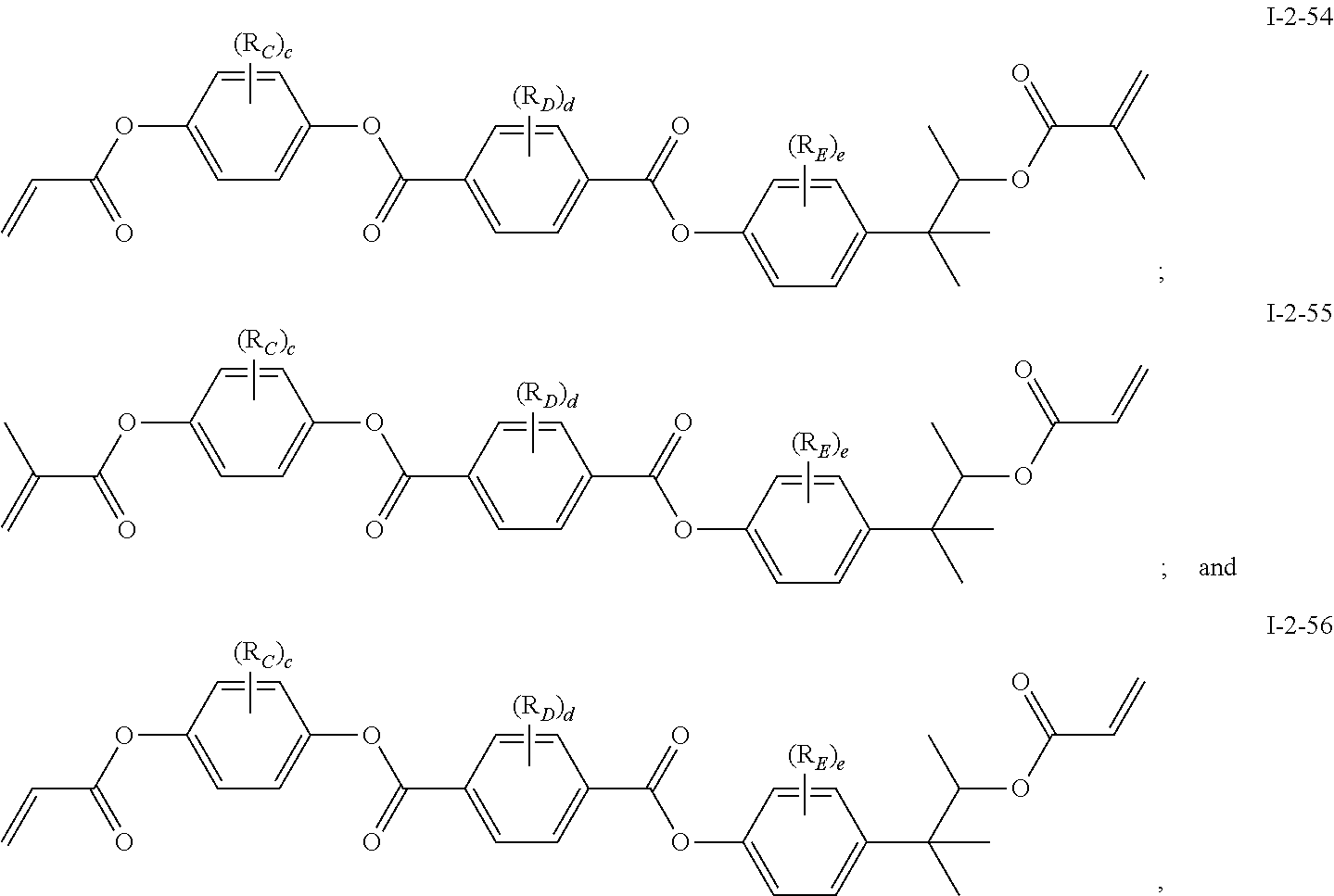
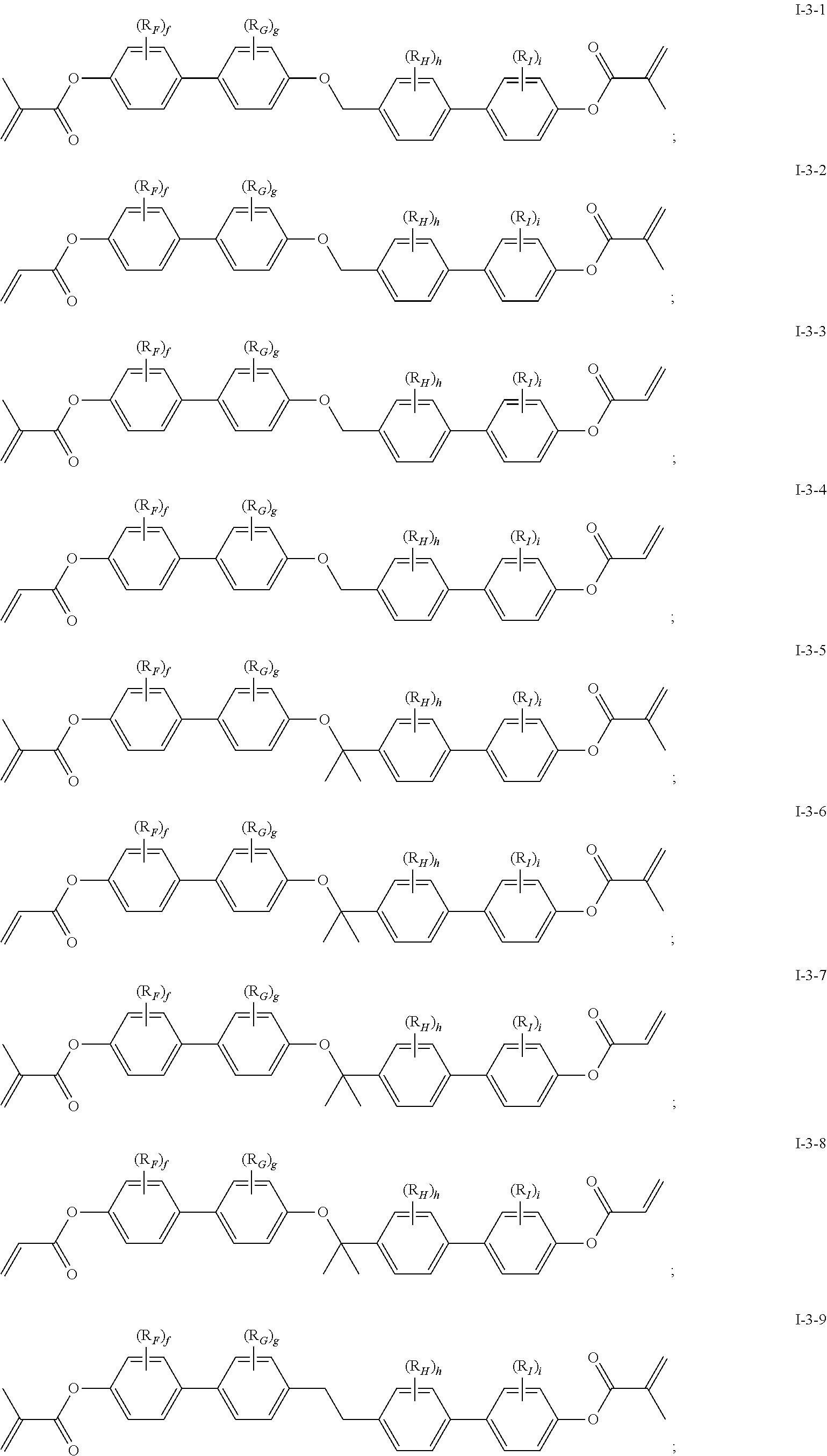



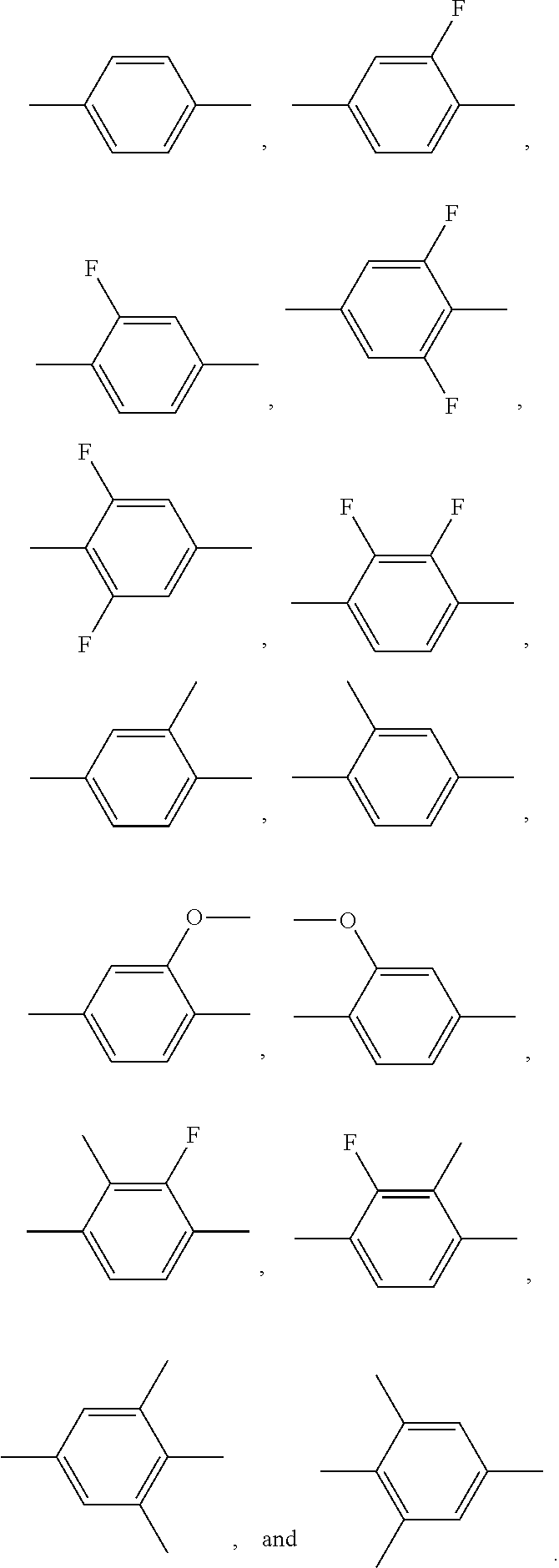




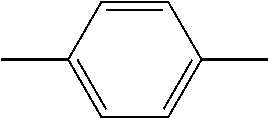
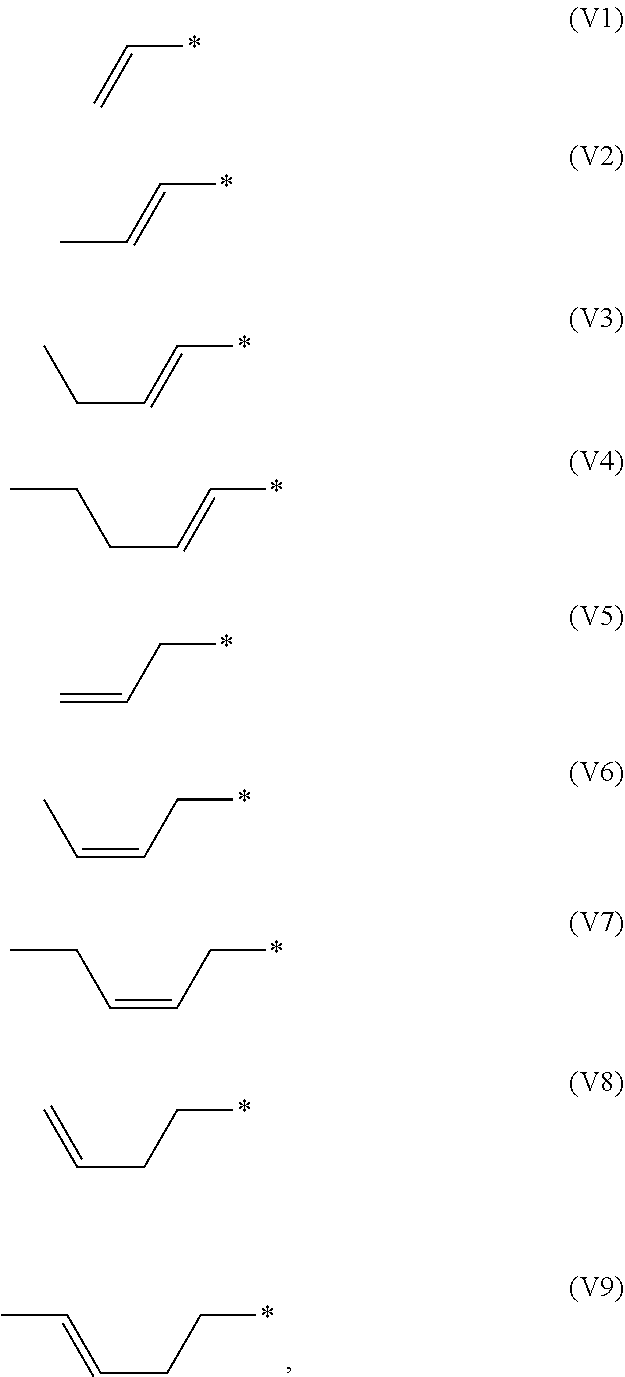
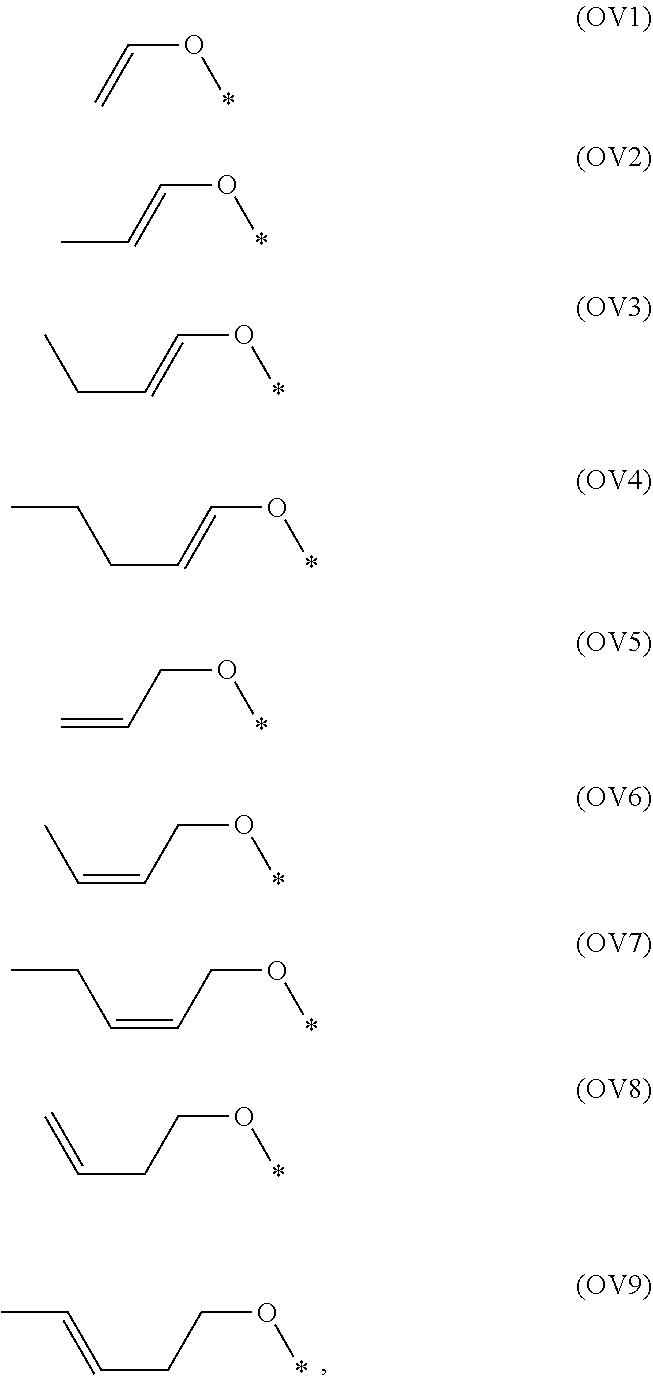





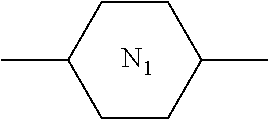
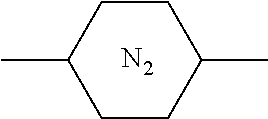





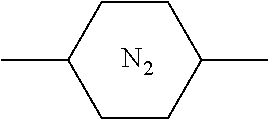


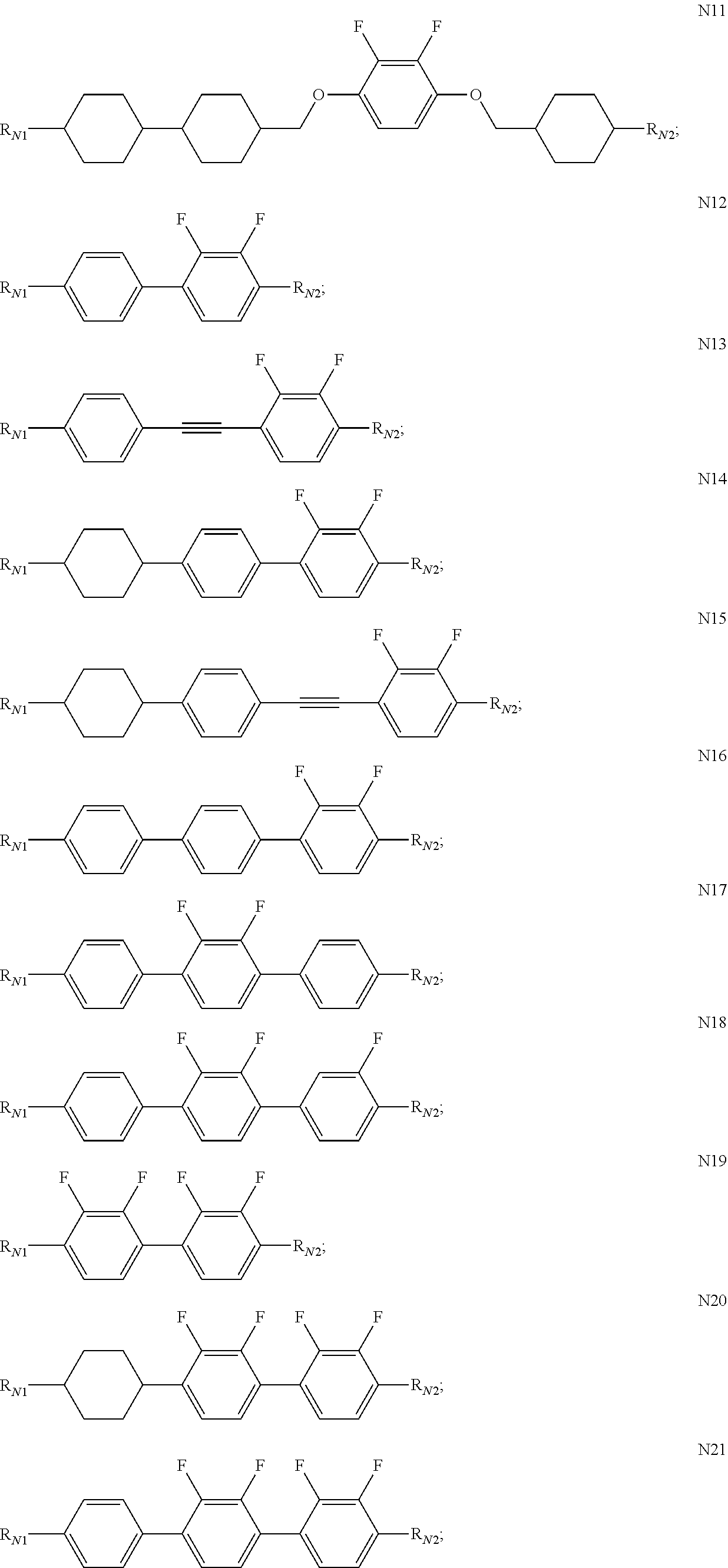



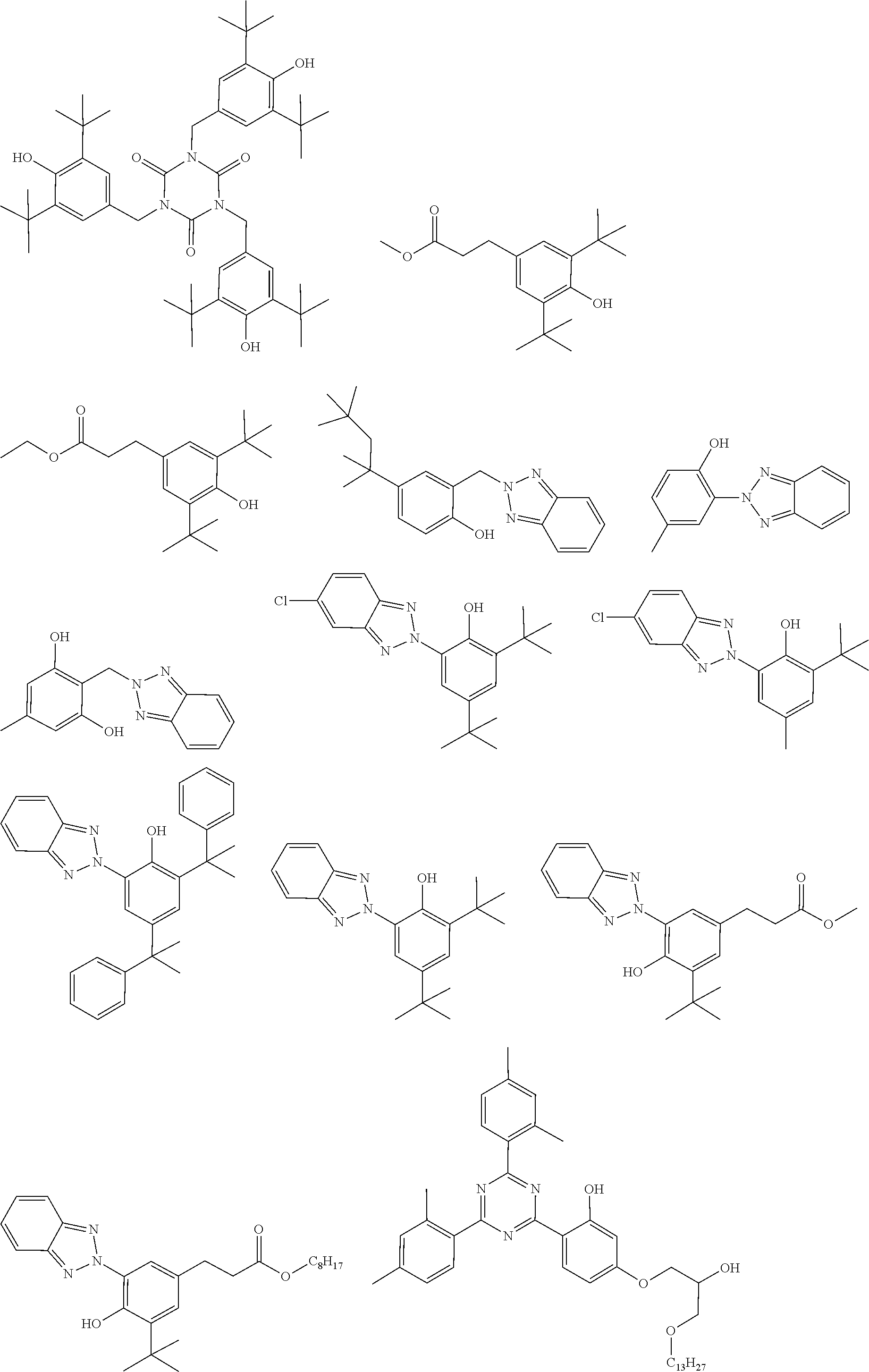
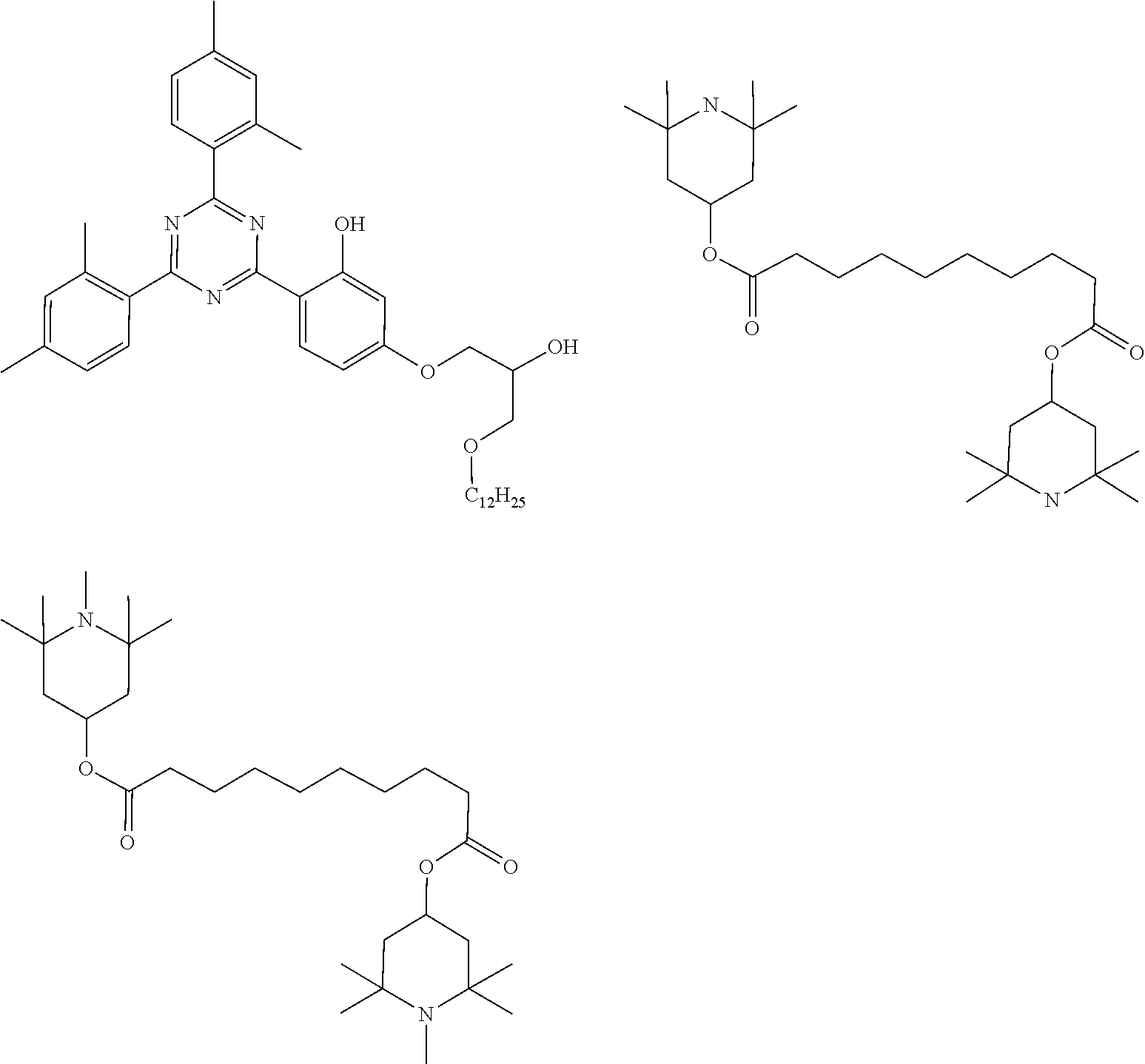
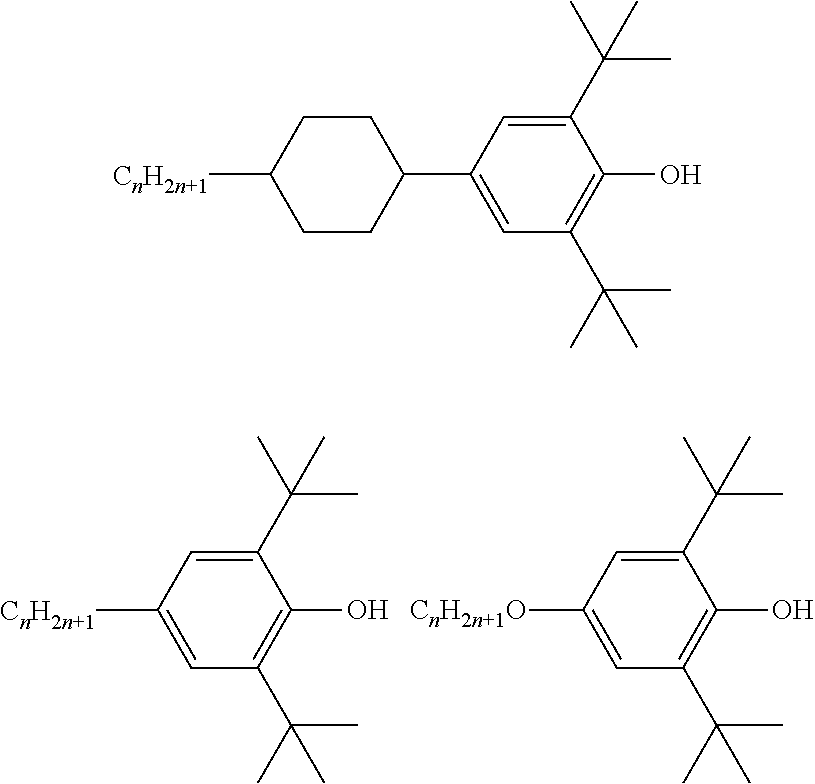
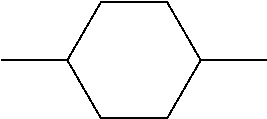

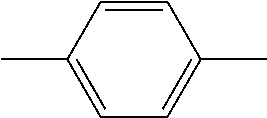
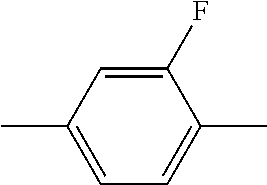
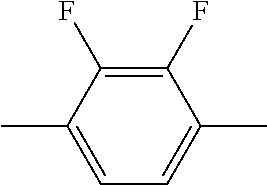

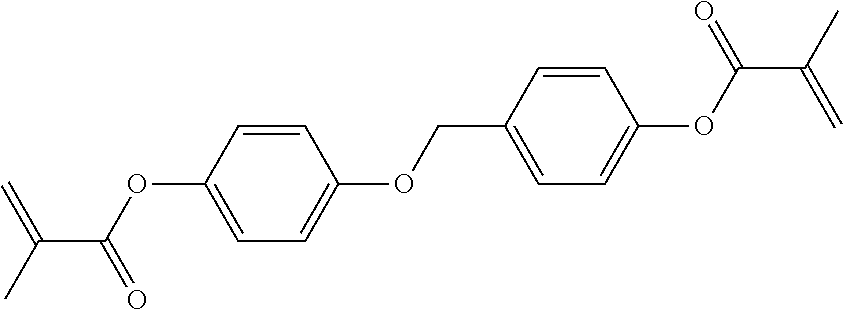
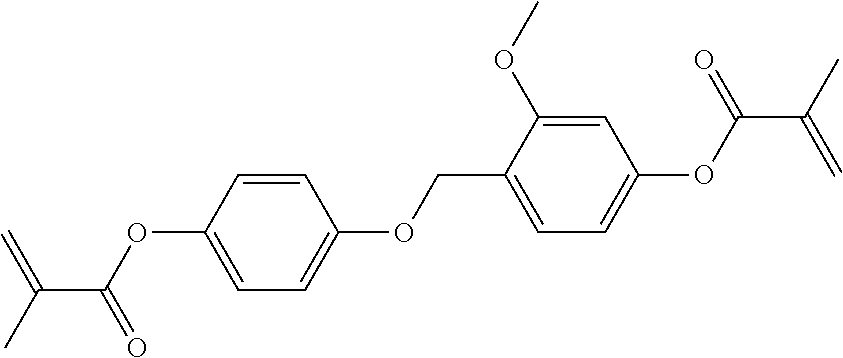

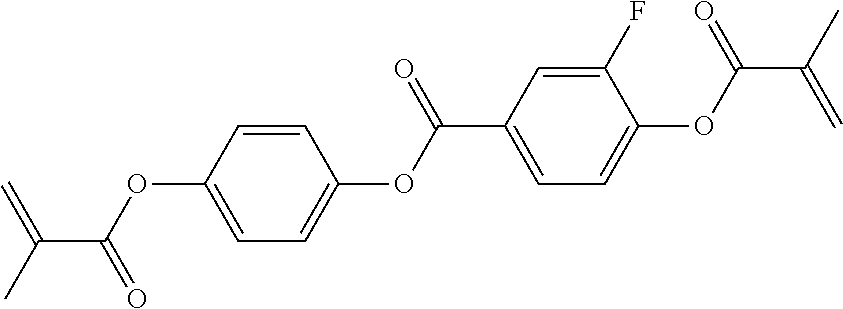

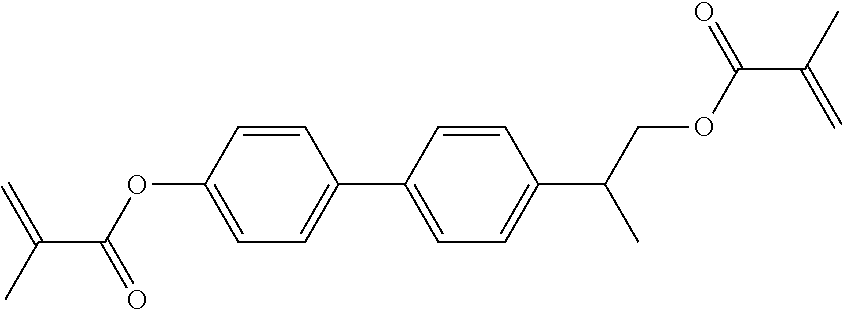













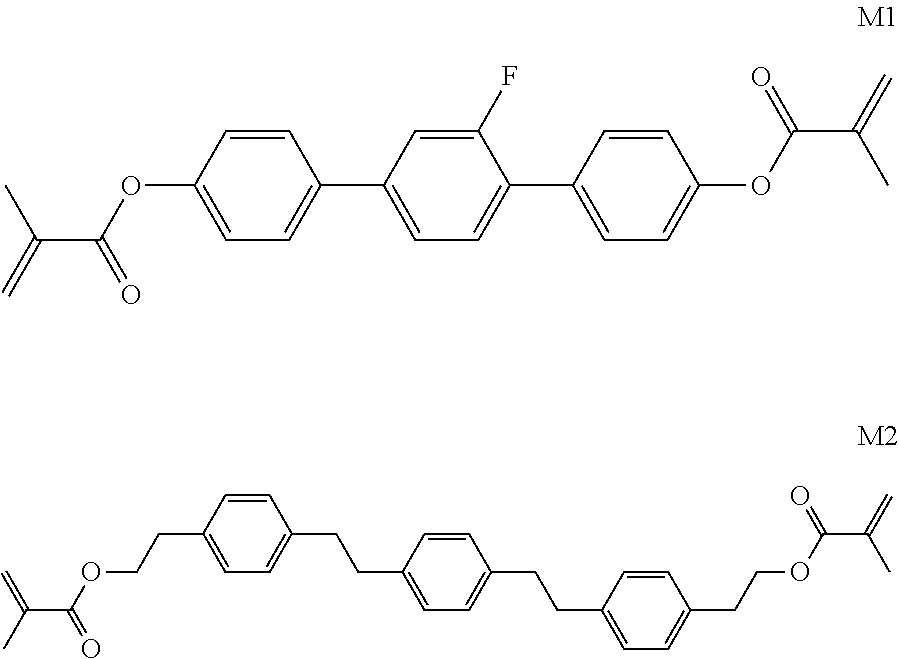
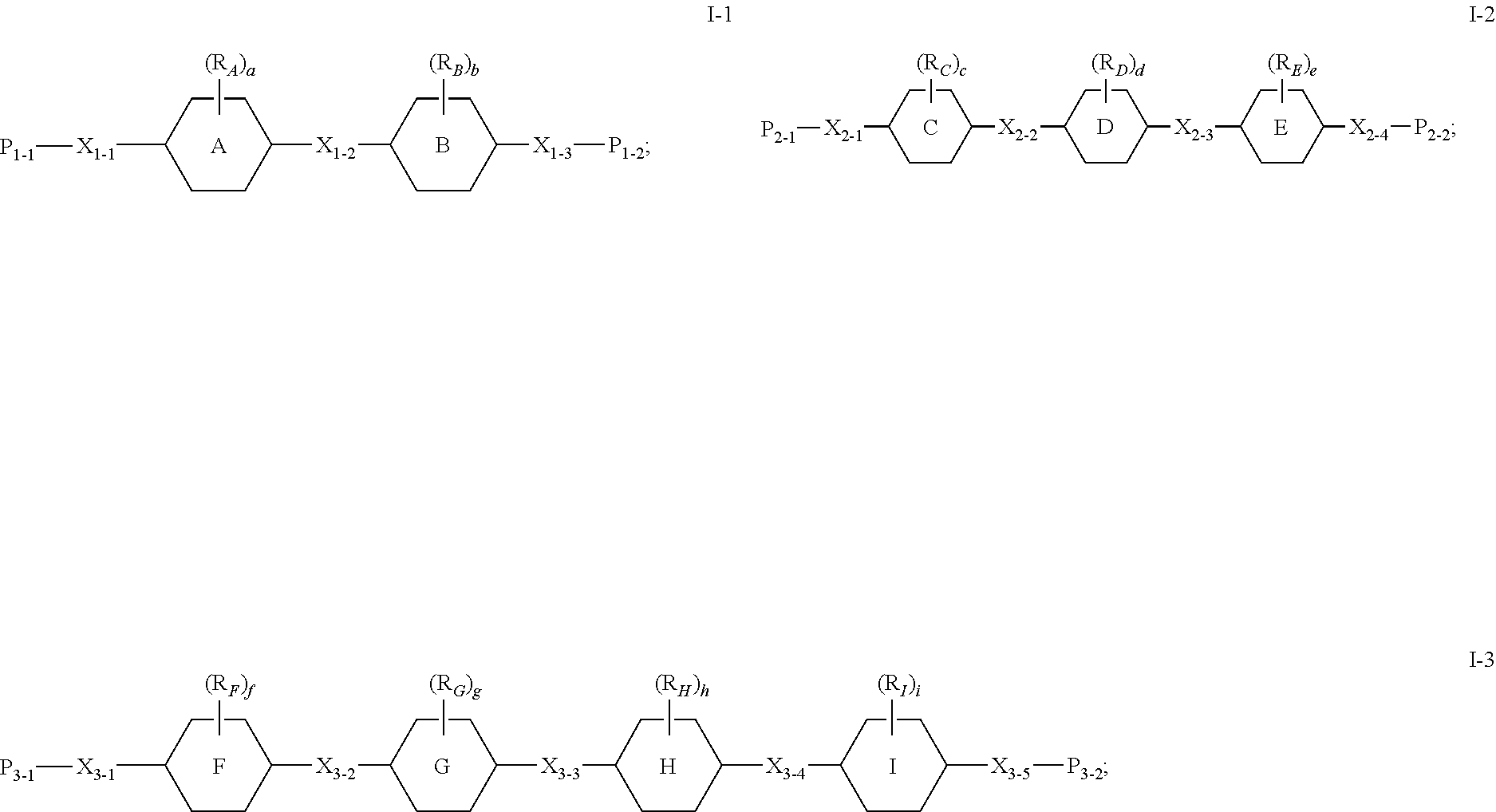



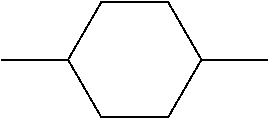

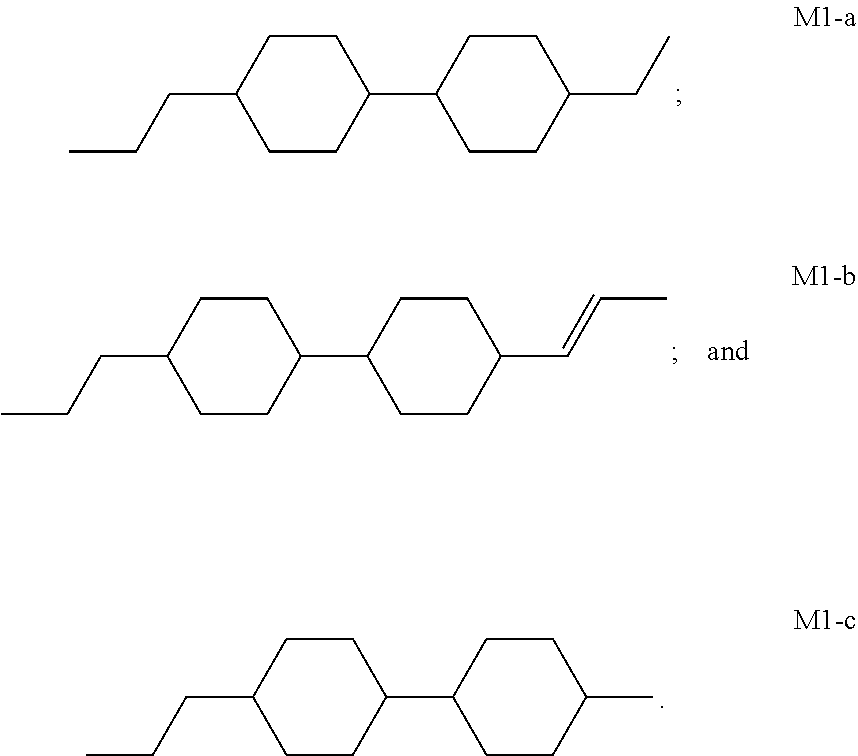



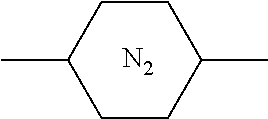

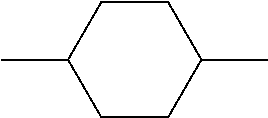

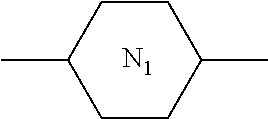
XML
uspto.report is an independent third-party trademark research tool that is not affiliated, endorsed, or sponsored by the United States Patent and Trademark Office (USPTO) or any other governmental organization. The information provided by uspto.report is based on publicly available data at the time of writing and is intended for informational purposes only.
While we strive to provide accurate and up-to-date information, we do not guarantee the accuracy, completeness, reliability, or suitability of the information displayed on this site. The use of this site is at your own risk. Any reliance you place on such information is therefore strictly at your own risk.
All official trademark data, including owner information, should be verified by visiting the official USPTO website at www.uspto.gov. This site is not intended to replace professional legal advice and should not be used as a substitute for consulting with a legal professional who is knowledgeable about trademark law.